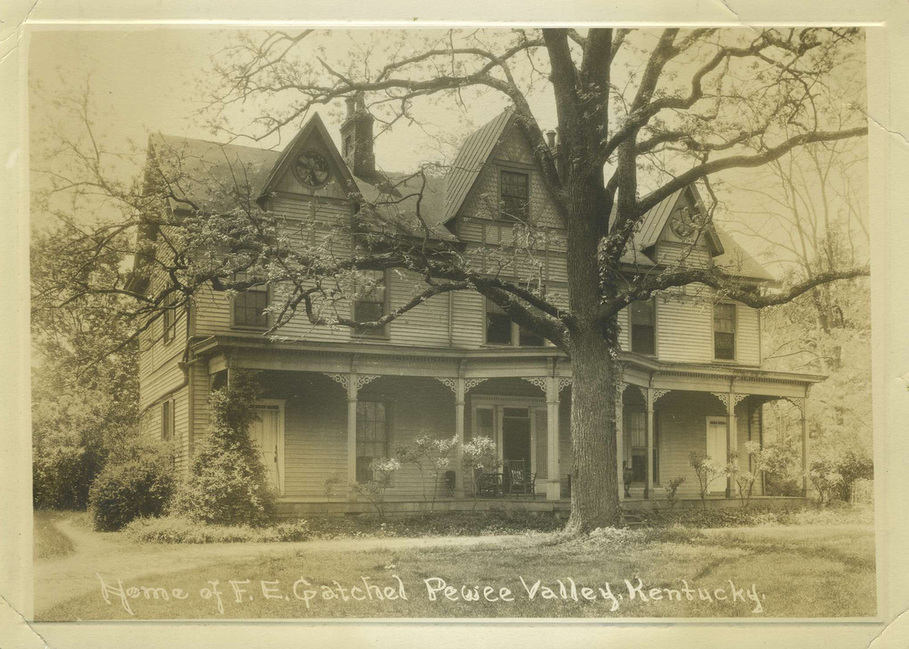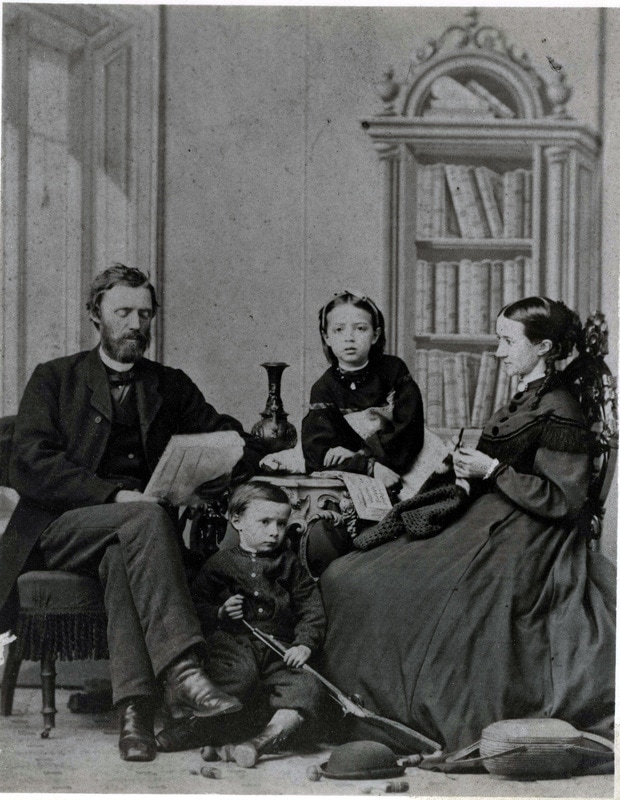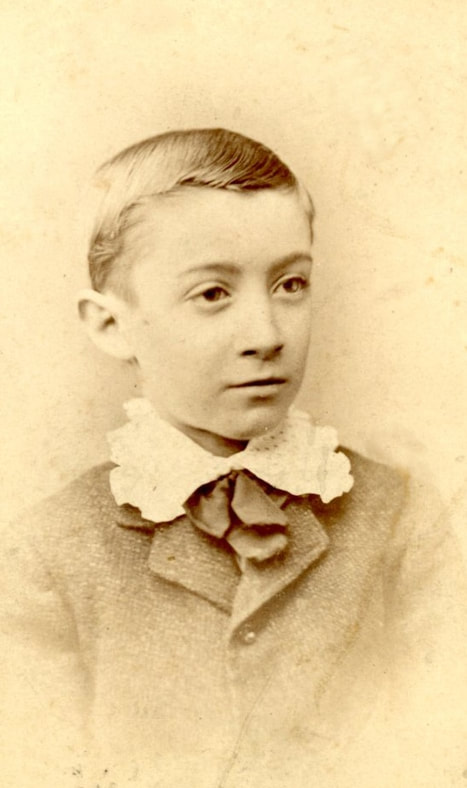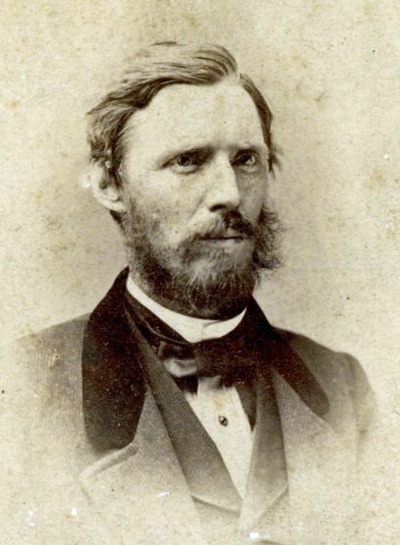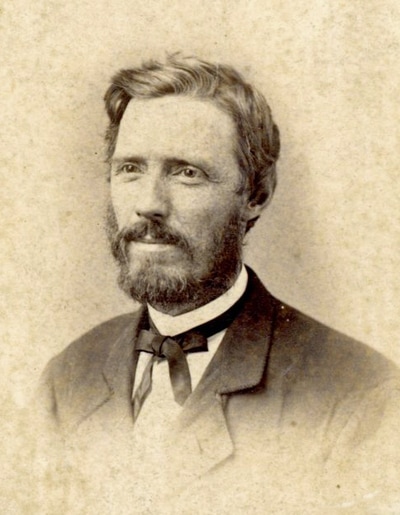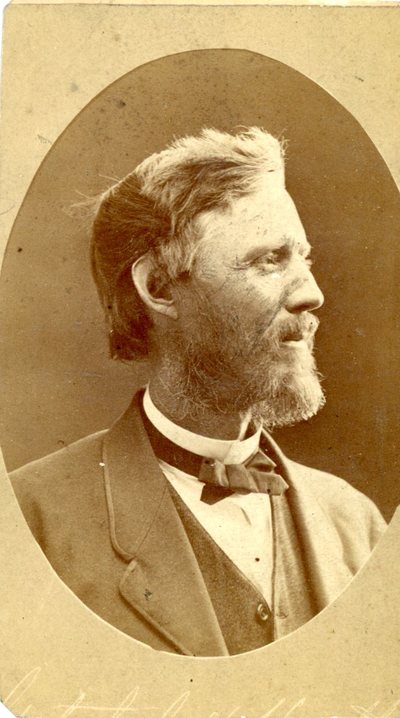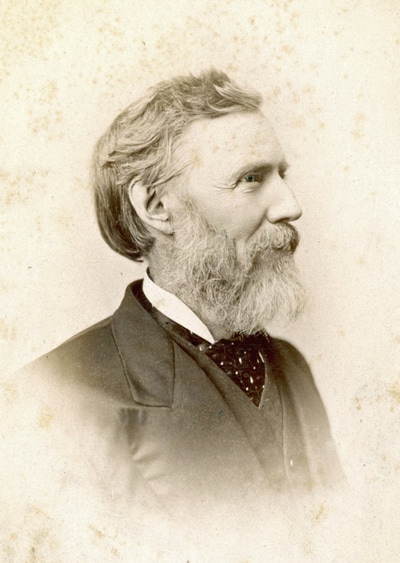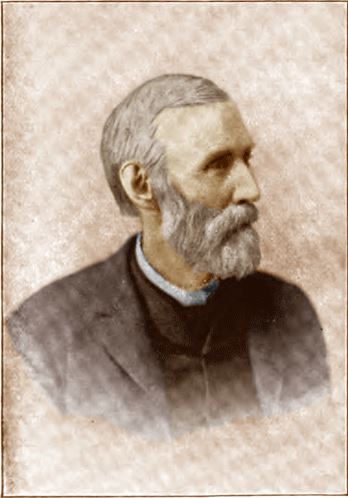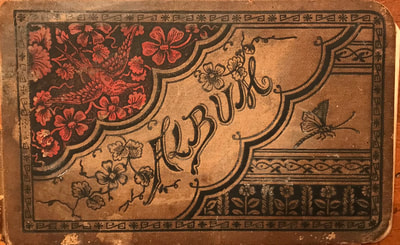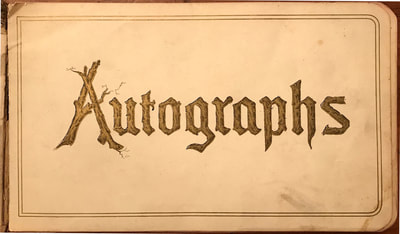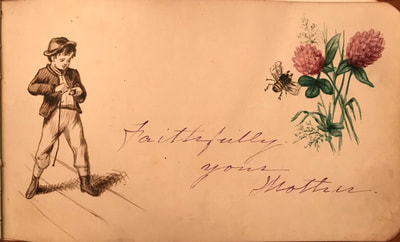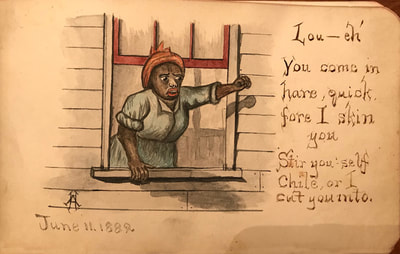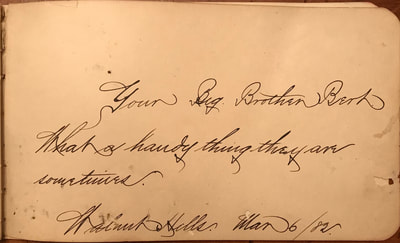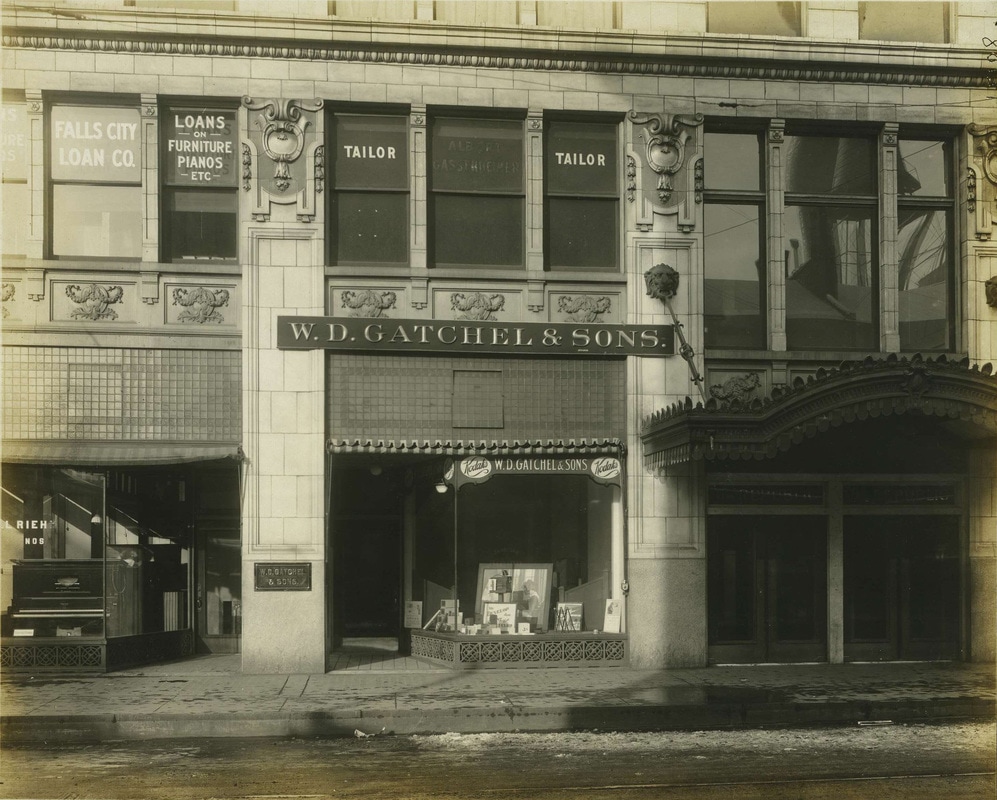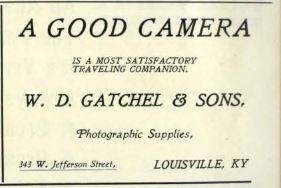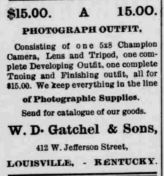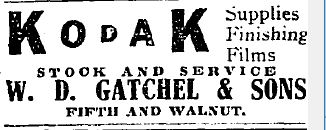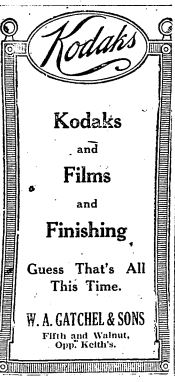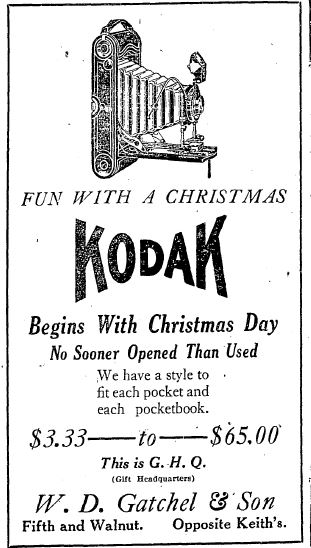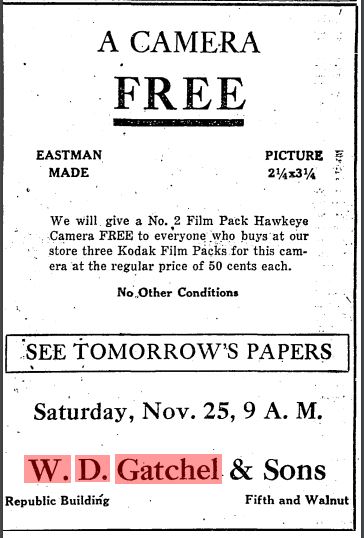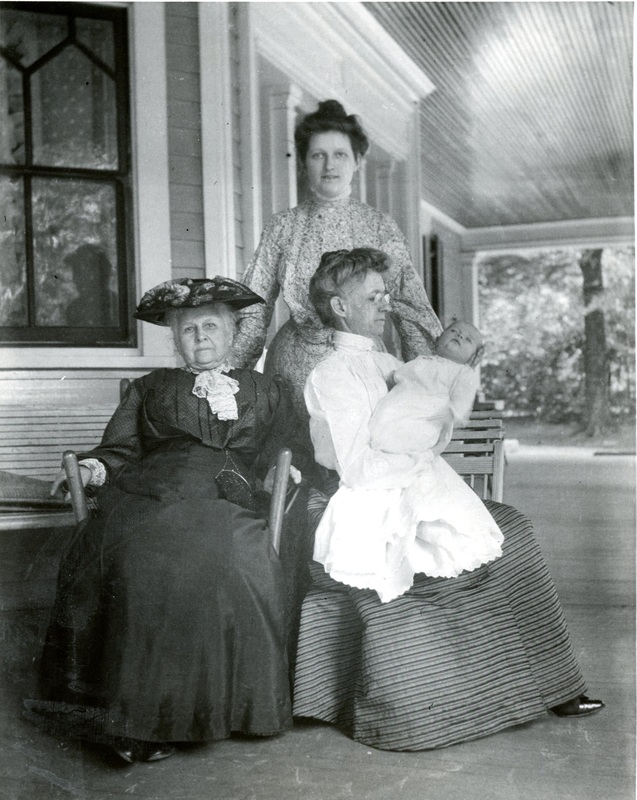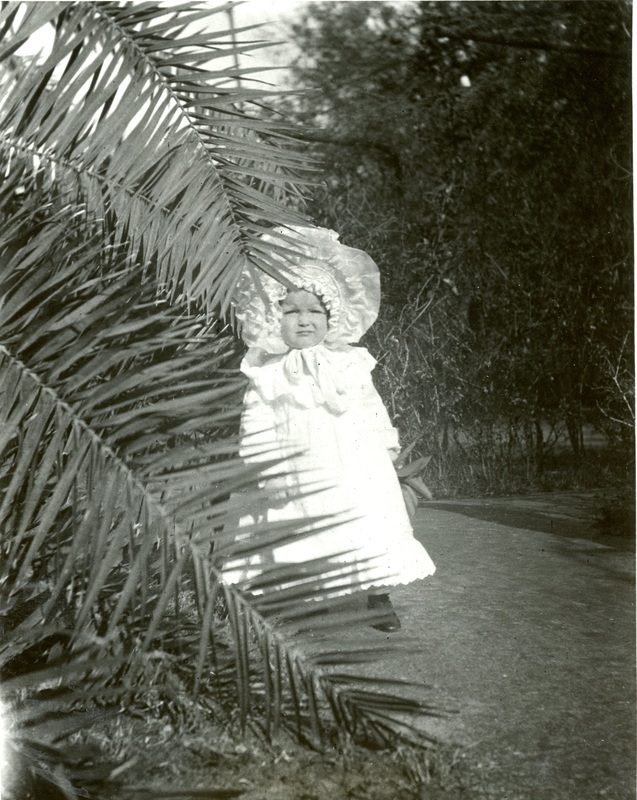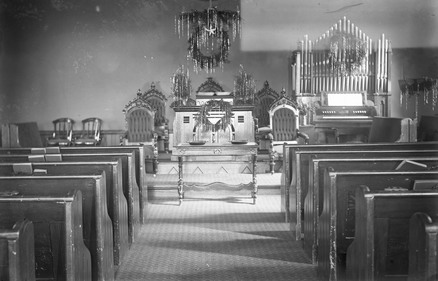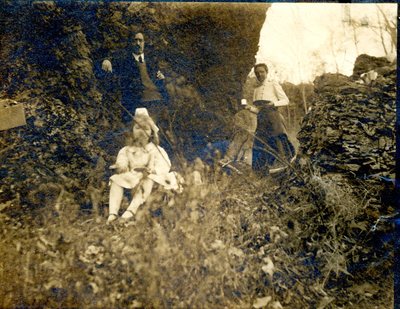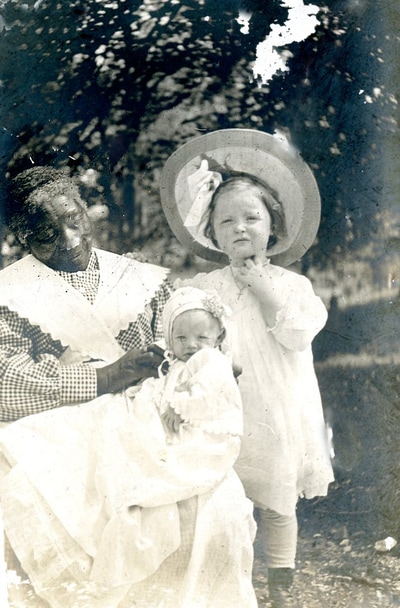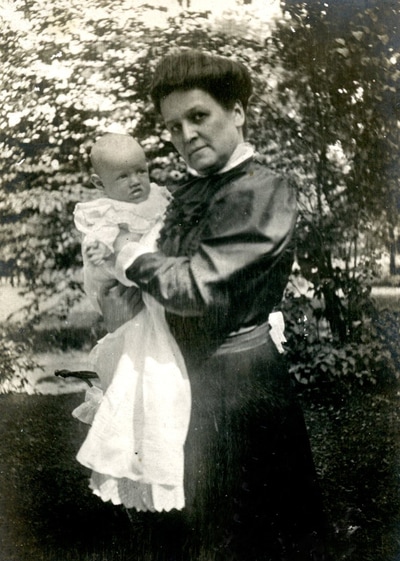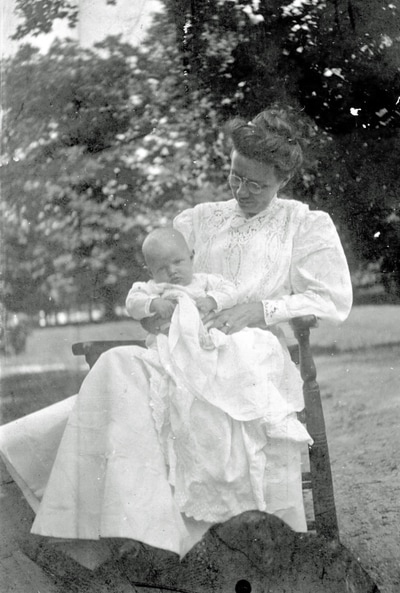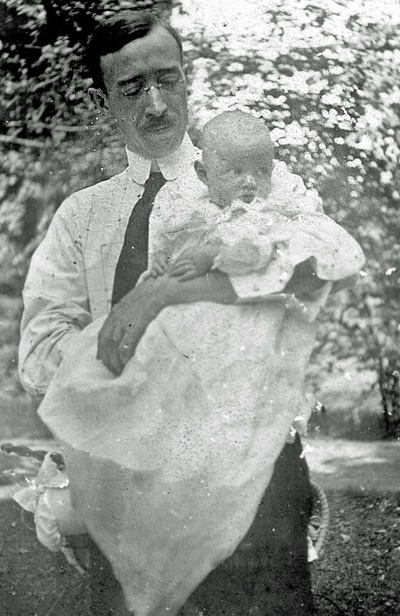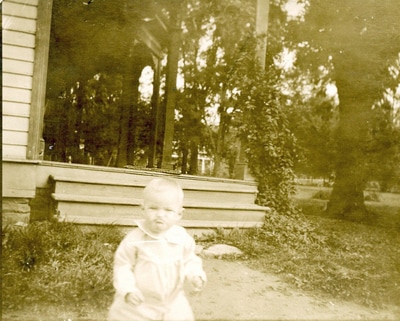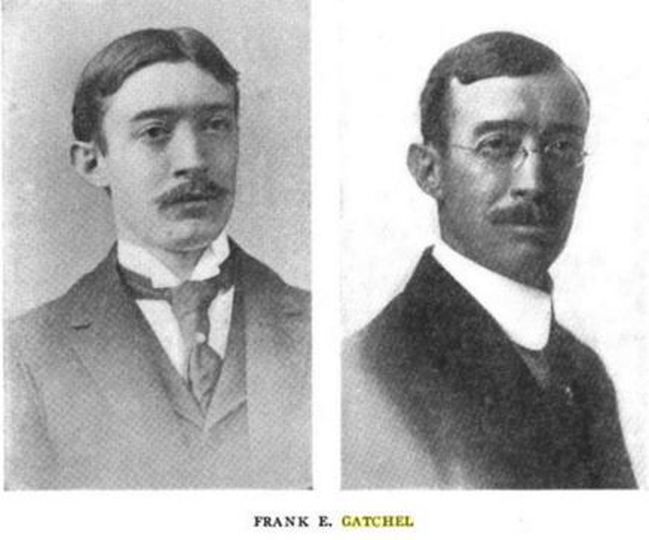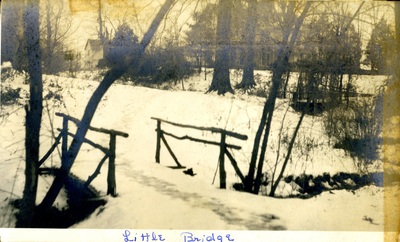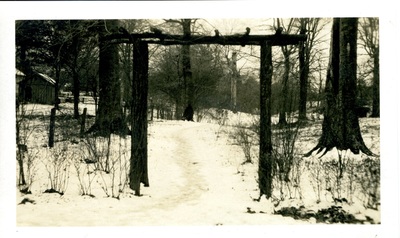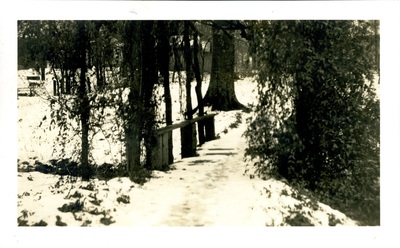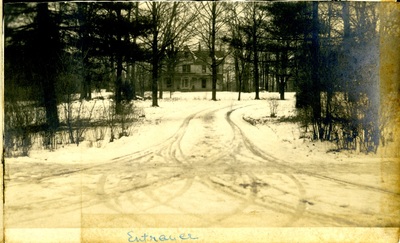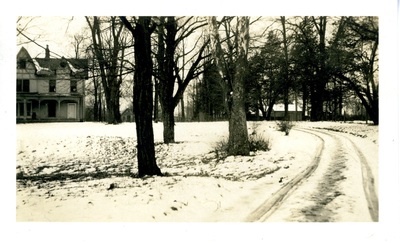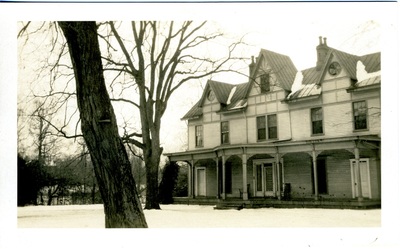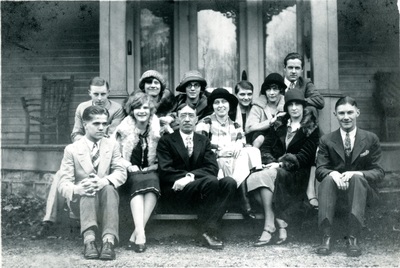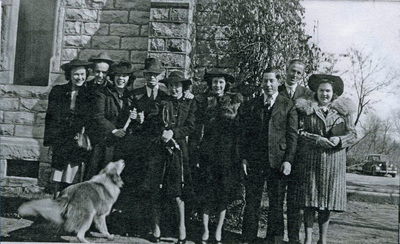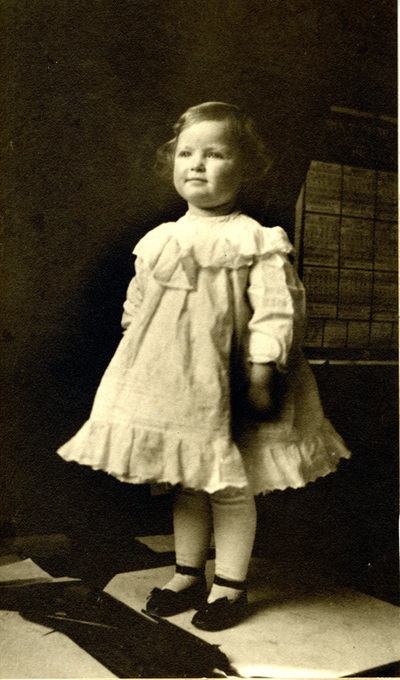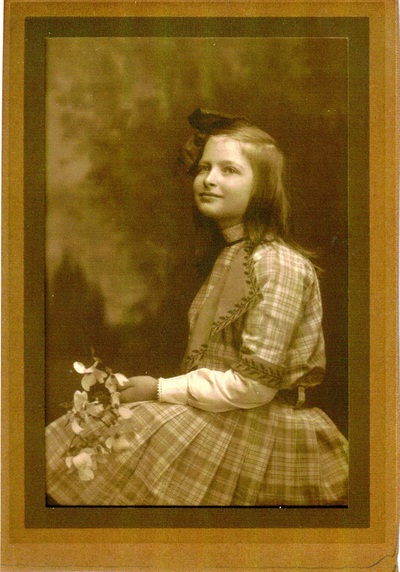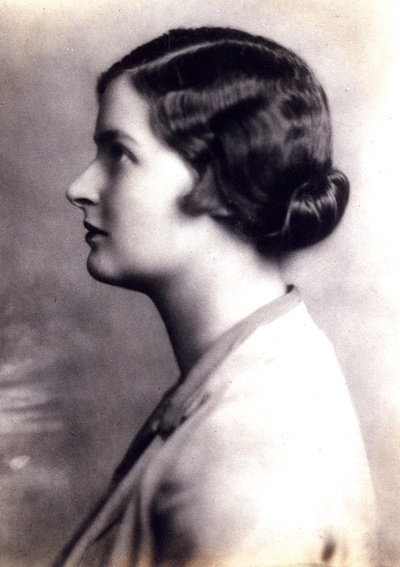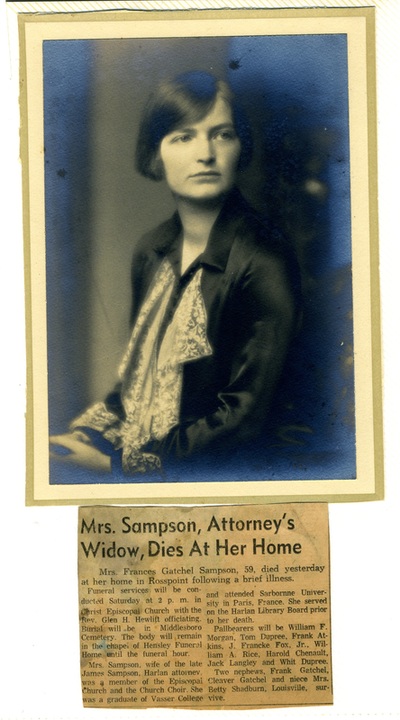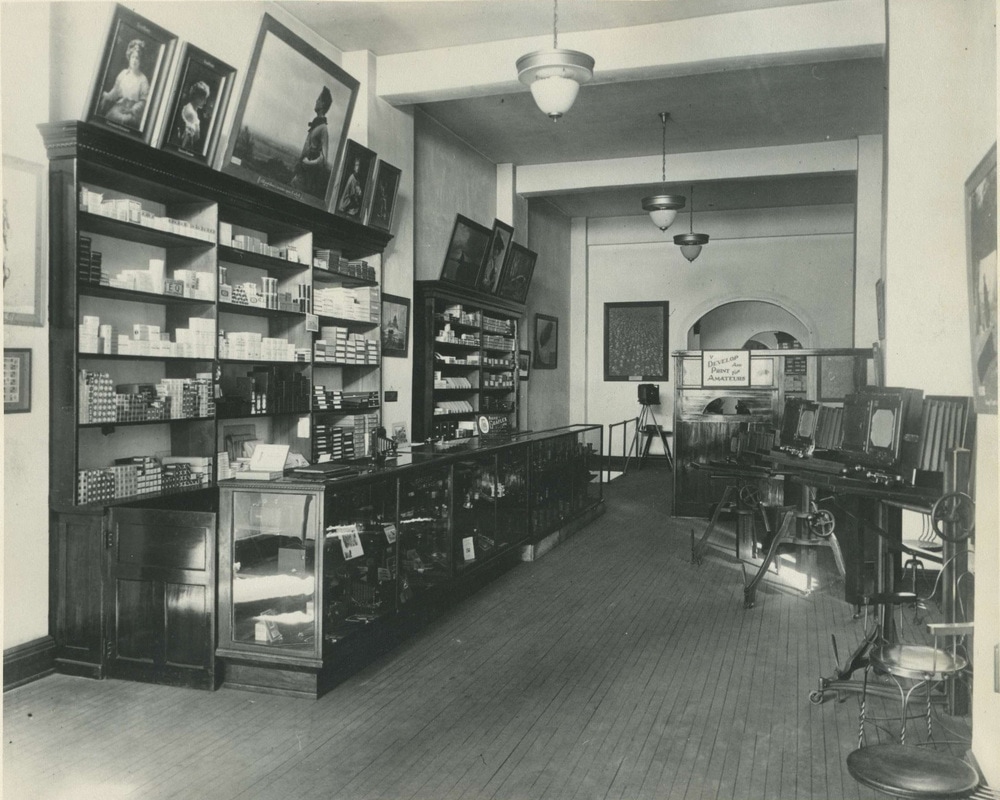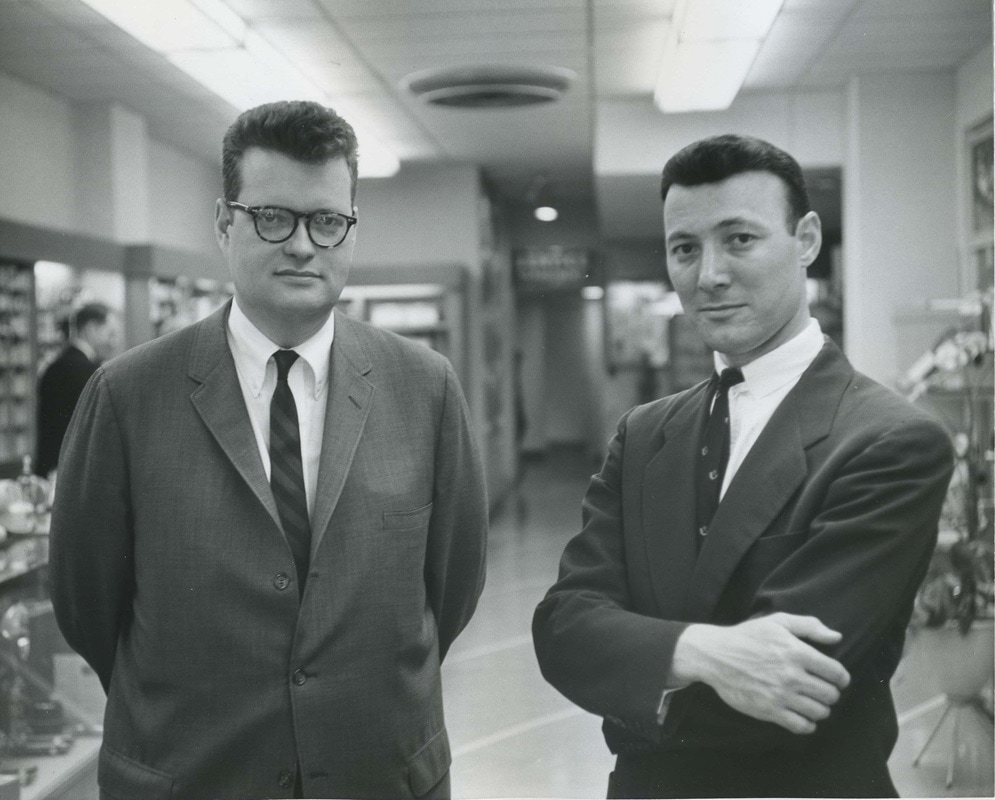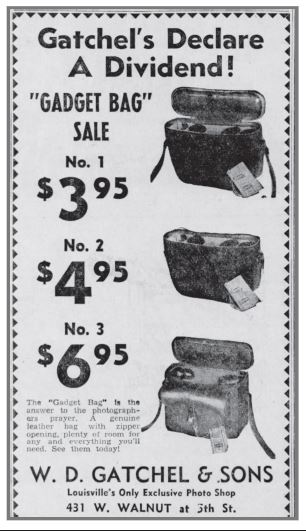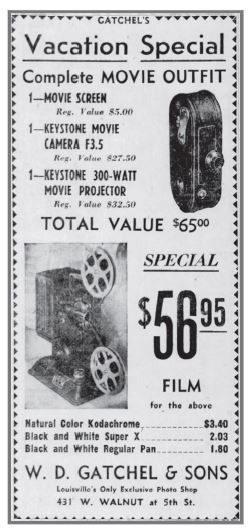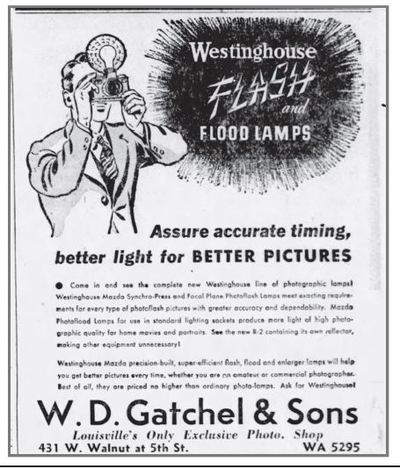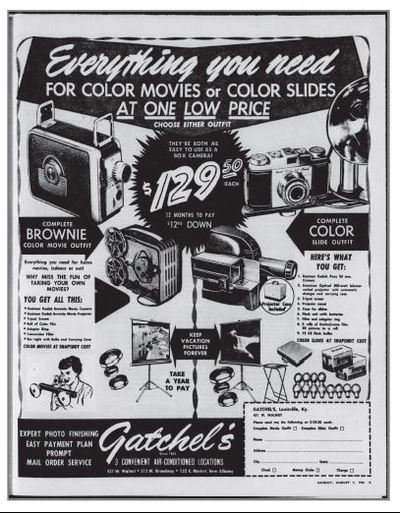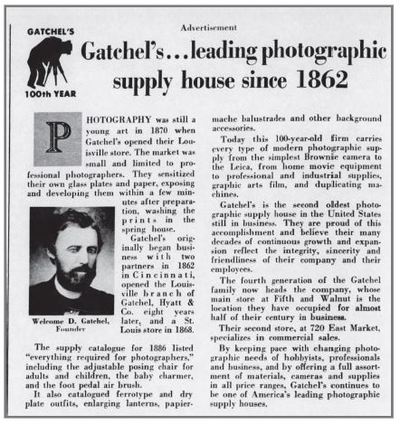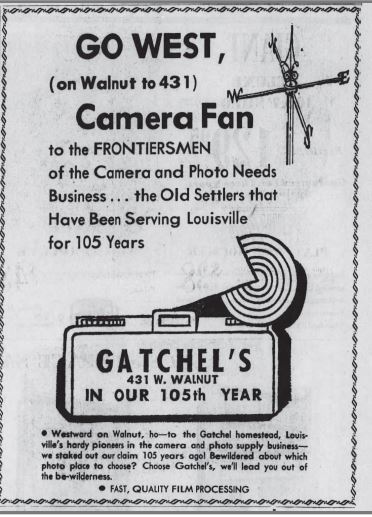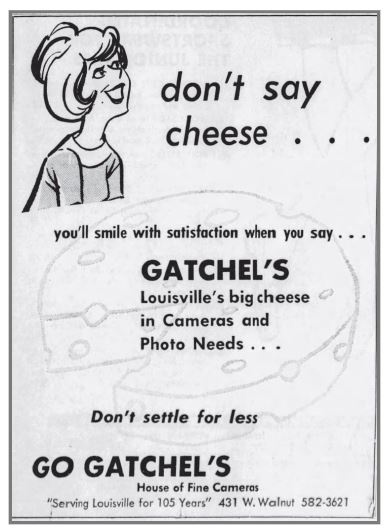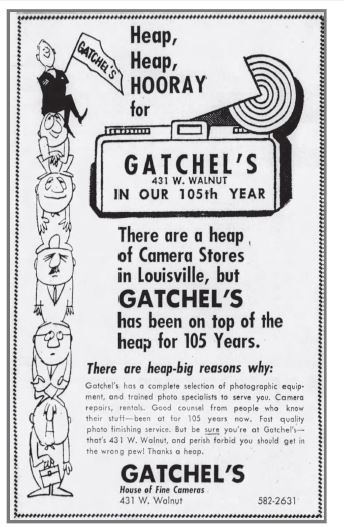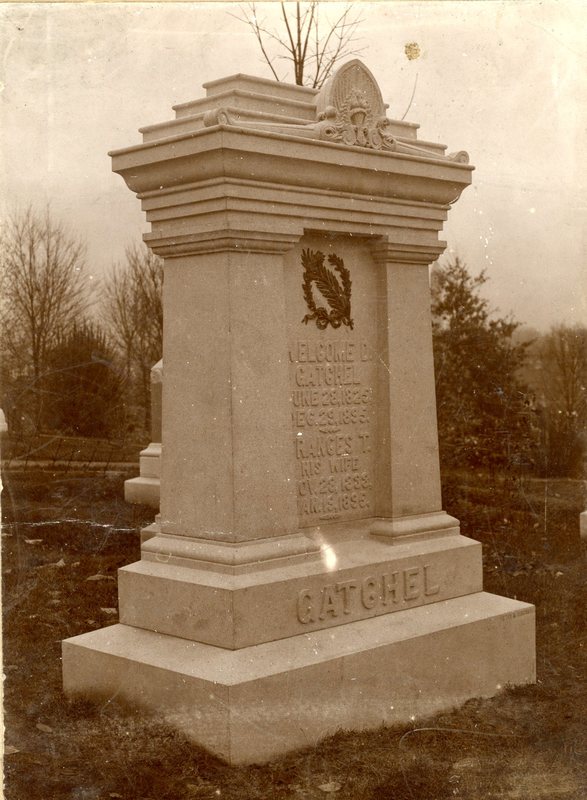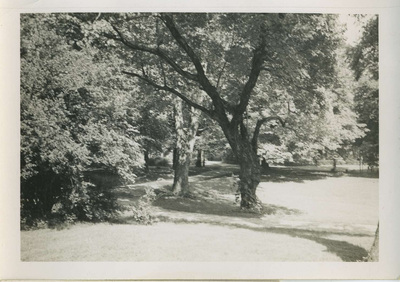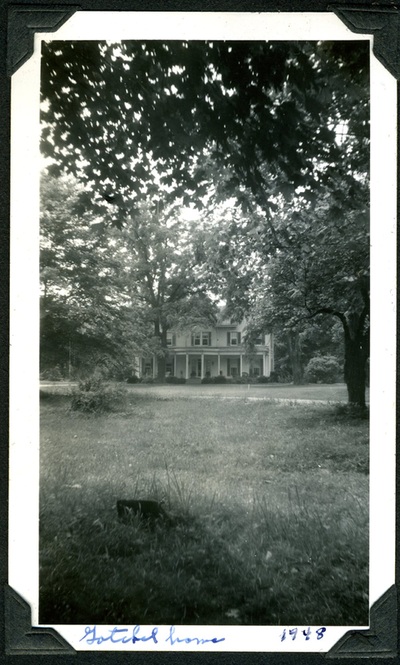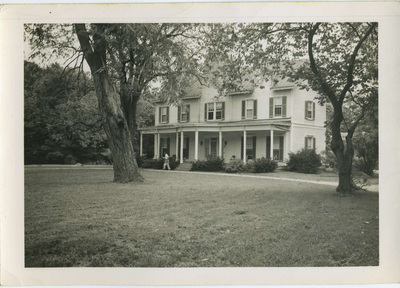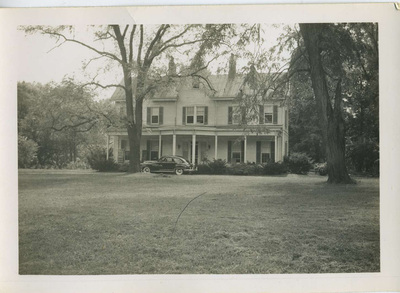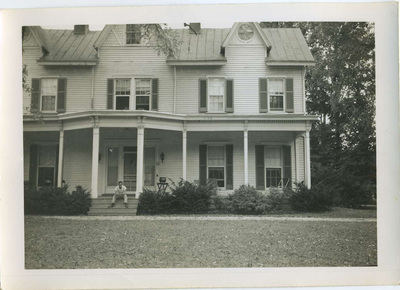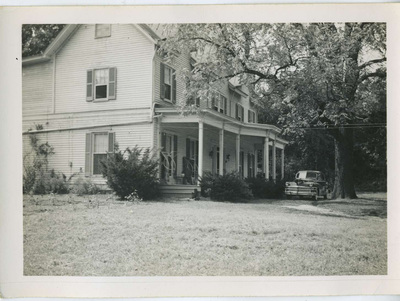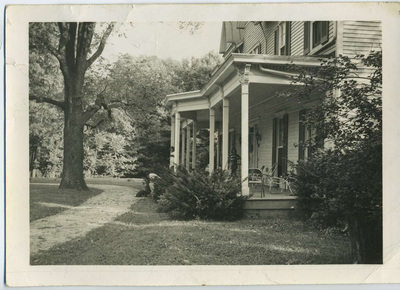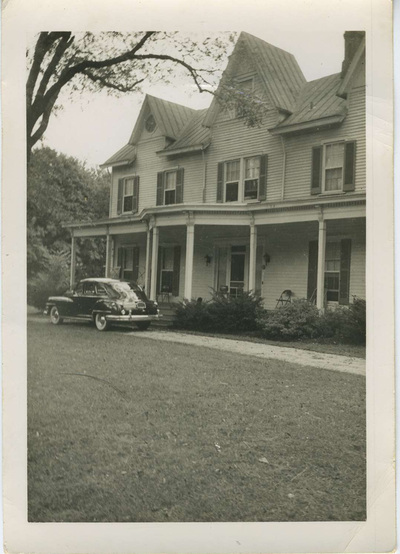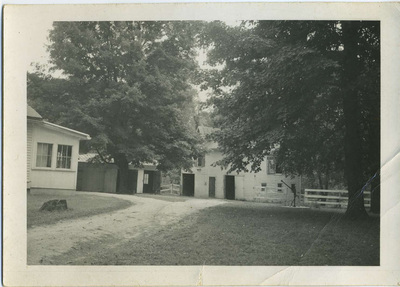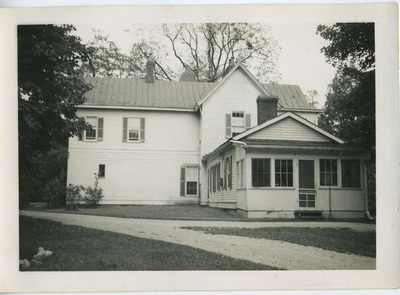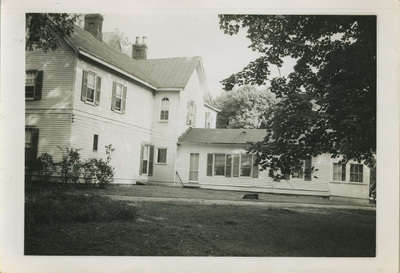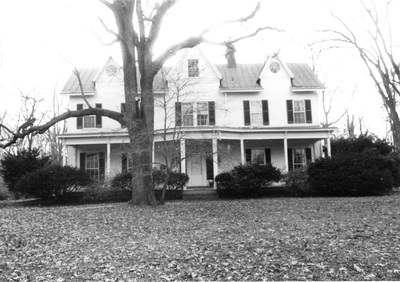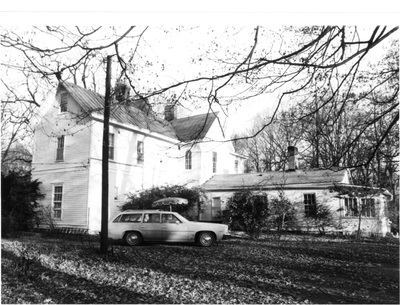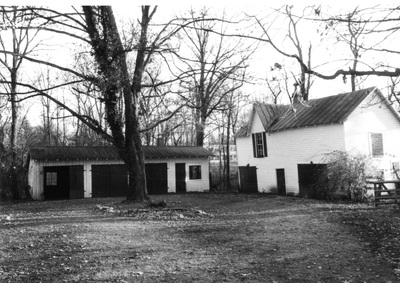Woodside Cottage: The Gatchel Years 1907-1944
After the Smiths sold Woodside in 1865, it changed hands a number of times. In 1879, according to the Beers & Lanagan map, it was owned by Dr. C.W. Babbit, who apparently used it as a boarding house. In 1907, it was purchased by Alice Craig Gatchel and her husband, Francis Edwin Gatchel. It remained in the Gatchel family until 1944.
Alice Craig Gatchel's Family Background
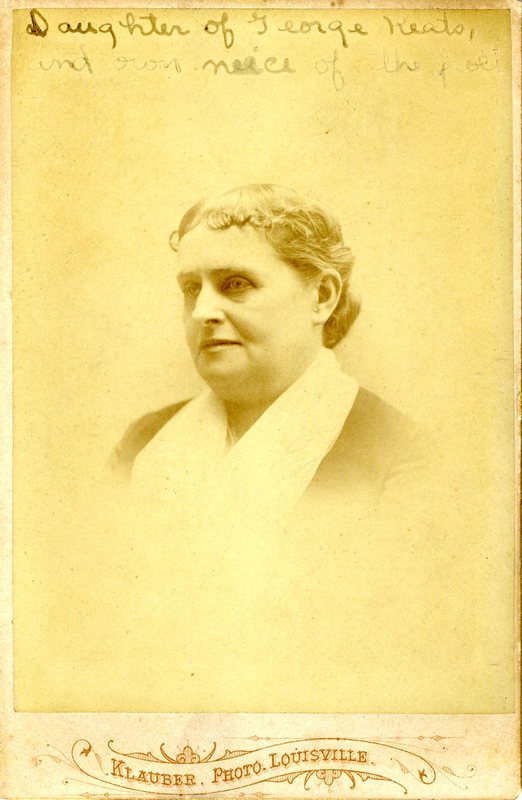 Ella Keats Peay (May 2, 1835-March 2, 1888) was Alice Craig Peay's paternal grandmother. She was the daughter of George Keats and the niece of the English Romantic poet John Keats. Courtesy of Ed Shadburne.
Ella Keats Peay (May 2, 1835-March 2, 1888) was Alice Craig Peay's paternal grandmother. She was the daughter of George Keats and the niece of the English Romantic poet John Keats. Courtesy of Ed Shadburne.
The Gatchels are Woodside’s Little Colonel connection. Alice Craig Gatchel was the granddaughter of Annie Craig, Annie Fellows Johnston’s model for Mrs. McIntyre in the novels. Alice’s mother, Alice Craig, had married Austin L. Peay on December 2, 1880 and died a year later on December 13, 1881, less than two months after giving birth to her daughter.
At the time of her final illness, her sister, Mary (Mamie) Craig, had recently become engaged to army Captain (later General) Henry Ware Lawton. Sensing the end was near, Alice begged her sister to marry quickly so she would be able to attend the wedding. Mamie telegraphed Henry and he obtained leave and left for Louisville by special train. Their wedding took place on December 12, 1881 at Alice's death bed. Alice died the next day. Mamie Craig Lawton, her husband and their children later became Annie Fellows Johnston’s models for the Walton family in the Little Colonel series.
Born October 30, 1855, Alice Gatchel's father, Austin Lightfoot Peay, was the son of George Nicholas and Ella Keats Peay and was descended from the Speed family of Farmington. Prior to marrying Alice, the 1880 census showed that Austin Peay was employed as an insurance clerk, just as his father George had been almost a decade earlier -- before he absconded with a large quantity of money he was holding for a friend and made a new life for himself in Canada! According to “The Keats Brothers: the life of John and George” by Denise Gigante (Harvard University Press; November 29, 2011):
… one day (George Nicholas) Peay went to the bank and emptied his safe deposit box of $25,000. He was headed to New York to deliver a bank draft for $4,700 on behalf of a clothing manufacturer in Louisville. But in New York, he cashed in the draft under a false name, and, equipped with a derringer pistol and a hunting knife, fled to Canada. Ella assumed that her husband had been robbed and put on mourning weeds. Her brother-in-law, George Speed Peay, hired a detective to search for her husband’s body, and Peay’s uncle filed a claim with his life insurance company on the widow’s behalf. But the insurance agents investigating the case found Peay in Montreal, working as a faro dealer and living with a woman of ill repute. Ella went to Montreal to persuade her husband to return, but he refused. She came back to Louisville pregnant with their eighth child.
The February 26, 1874 Courier-Journal reported on George Nicholas Peay's disappearance and subsequent discovery in an article called, "George Peay's Pefidy;"
The intelligence of the discovery of George Peay's whereabouts was detailed in these columns a day or two since. Further information concerning this affair has been obtained, making it altogether a story of such sad degradation of a once respected citizen to a depth of utter depravity as to warrant a full detail here.
Three years ago, George Peay had, perhaps, as high standing as any man of his age in the city. He was in a prosperous business, was of a family which numbered among its members men of high position in the nation, was married to an estimatable woman and blessed with several children; was a man of many friends -- surrounded, in short, with all the influences which go to make a happy and contented life. Two years ago his business connection was severed, for what reason has not been stated. Shortly afterwards, misfortune overtook a prominent merchant of this city -- a Mason; and a sum of money was made up by his brothers of the order and personal friends, which would enable him to bridge over his present difficulties, and to start again in business. The debts were due in New York; George Peay was entrusted with the money -- himself, we believe a Mason -- and sent to New York to discharge the obligations of his distressed friend.
George Peay never paid those debts. He obtained the money upon the drafts which he had taken with him; was seen late one night in one of the New York hotels -- and then disappeared. The metropolis, just at the time, was agitated over the many and mysterious disappearances of citizens and strangers. It was before Foster was hanged and Tweed sent to the penitentiary. Murder ran riot and street robbery was a nightly occurence. The lax law was defied and no man's life or property was safe. There was extraordinary vigilance shown in the attempt to discover criminals -- true, after the crime had been committed; still there was something novel in the attempt even being made. So, when George Peay was not seen the next day, nor the next, after he bade goodbye to a friend that night, anxiety was felt as to his fate. Anxiety grew into alarm; the papers took the matter up, and demanded of the police that the missing man be found or shown cause why he had not been murdered. The intelligence of his singular disappearance was transmitted to his friends and family here, and a Louisville detective, the famous "Yankee" Bligh, was sent to help the New York police in their search. It was found that Peay had a large amount of money on his person that night -- the money belonging to the embarassed Louisville merchant -- and he had last been seen in a remote and dangerous part of the city.
So day after day the search went on. The city journals teemed with its details, and the subject was the daily sensation of the press dispatches. George Peay's name was of frequent mention in the newspapers throughout the country, and not since Rufus King threw himself into the North River had public attention been so prominently directed to a mystery which was expected to find its end in the Morgue.
But the search was fruitless, and George Peay was believed by the public generally, and the discreet New York police in particular, to have been murdered for his money and his body effectually disposed of. His wife sadly arrayed herself in her mourning weeds; his widowed mother and his family mourned him as dead. Mr. H.H. Neal, whose money had been lost with the missing man, perhaps believed it to have found its way from the pockets of George Peay's murdered to the treasury of some gambling den, or the ill-gotten money box of an even more disreputable resort of bloody-handed thieves. And the popular mind settled down to this conviction, and after awhile, George Peay was forgotten, except within the home of his family, and by the man who had lost much by his untoward death.
There was a suspicion that all was not right when his box at the bank was opened and found to be empty, save of some worthless papers. Still no man seemed to have a well-formed suspicion of what has turned out to be the truth, except the close-mouthed and incredulous Bligh, who doesn't believe much in the rectitude of men's motives, any how.
Some weeks back Hon. James Speed, a near relative of George Peay, applied, as attorney for the widow, to the life insurance company for the payment of a policy of $10,000 upon the missing man's life. The agent of the company declined to pay the money, but offered, in its stead, to produce the body of George Peay, not dead, but in the enjoyment of the most exuberant health and spirits. This led, of course, to startled inquiries, and, a day or so afterward, to the departure of Mr. John Speed, another relative, and a well-known young gentleman of this city, in a northward bound train. But young Mr. Speed would have been recognized there by very few who know him well here, for he was much changed from his ordinary appearance. In fact, it was not intended that he should be recognized and by no one less than his cousin, George Peay. Mr. Speed's destination was Montreal, and in Montreal the insurance agent had guaranteed to produce the person of the missing man. The story, thereafter, is a very sad one for family and friends, and the pity of the community will be with them that depraved husband and father was not, indeed, dead.
The facts have not been developed but the seemingly well-founded report is that the degraded man has been living in Montreal for a year or back with an equally abandoned woman. Young Mr. Speed, as the report goes, ascertained that the two were living together in a very disrutable house. There is a drug store near by, and here Mr. Speed inquired if any note had ever been sent from the house in question. An order for medicines was shown him, in George Peay's handwriting. Still in disguise Mr. Speed went to a notorious gambling-house, and here -- so the story hath it -- George Peay was sitting at a faro table, dealing to an eager frontage of players. It does not appear that Mr. Speed was recognized; he shortly returned to Louisville and, a few days since, Detective Bligh and Mr. H.H. Neal started for Montreal, where they now are. It was also currently reported upon the streets yesterday that Mr. George Buchanon, of the firm Newcomb, Buchanon and Co,. Inc., who had been active in making up the money which had disappeared with George Peay, received a dispatch from Mr. Neal confirming the details as above given. A reporter of the COURIER-JOURNAL unsuccessfully attempted to see Mr. Buchanon yesterday, but obtained the facts as above stated from those who are in a position to know of the truth.
George Peay, pity 'is, is not dead; nor will Mr. Neal recover his money. The discriminating laws of Kentucky do not punish a "breach of trust," and this was all the perjured man appears to have committed. In other words, the law says to a man disposed to villainy, "get your friend's entire confidence, or convince your employer of your absolute reliability -- induce him to repose his trust and his money in your hands, and then rob him of both. I will protect you from the consequences."
Which is putting a premium upon perfidy, and George Peay availed himself of it.
George Peay never paid those debts. He obtained the money upon the drafts which he had taken with him; was seen late one night in one of the New York hotels -- and then disappeared. The metropolis, just at the time, was agitated over the many and mysterious disappearances of citizens and strangers. It was before Foster was hanged and Tweed sent to the penitentiary. Murder ran riot and street robbery was a nightly occurence. The lax law was defied and no man's life or property was safe. There was extraordinary vigilance shown in the attempt to discover criminals -- true, after the crime had been committed; still there was something novel in the attempt even being made. So, when George Peay was not seen the next day, nor the next, after he bade goodbye to a friend that night, anxiety was felt as to his fate. Anxiety grew into alarm; the papers took the matter up, and demanded of the police that the missing man be found or shown cause why he had not been murdered. The intelligence of his singular disappearance was transmitted to his friends and family here, and a Louisville detective, the famous "Yankee" Bligh, was sent to help the New York police in their search. It was found that Peay had a large amount of money on his person that night -- the money belonging to the embarassed Louisville merchant -- and he had last been seen in a remote and dangerous part of the city.
So day after day the search went on. The city journals teemed with its details, and the subject was the daily sensation of the press dispatches. George Peay's name was of frequent mention in the newspapers throughout the country, and not since Rufus King threw himself into the North River had public attention been so prominently directed to a mystery which was expected to find its end in the Morgue.
But the search was fruitless, and George Peay was believed by the public generally, and the discreet New York police in particular, to have been murdered for his money and his body effectually disposed of. His wife sadly arrayed herself in her mourning weeds; his widowed mother and his family mourned him as dead. Mr. H.H. Neal, whose money had been lost with the missing man, perhaps believed it to have found its way from the pockets of George Peay's murdered to the treasury of some gambling den, or the ill-gotten money box of an even more disreputable resort of bloody-handed thieves. And the popular mind settled down to this conviction, and after awhile, George Peay was forgotten, except within the home of his family, and by the man who had lost much by his untoward death.
There was a suspicion that all was not right when his box at the bank was opened and found to be empty, save of some worthless papers. Still no man seemed to have a well-formed suspicion of what has turned out to be the truth, except the close-mouthed and incredulous Bligh, who doesn't believe much in the rectitude of men's motives, any how.
Some weeks back Hon. James Speed, a near relative of George Peay, applied, as attorney for the widow, to the life insurance company for the payment of a policy of $10,000 upon the missing man's life. The agent of the company declined to pay the money, but offered, in its stead, to produce the body of George Peay, not dead, but in the enjoyment of the most exuberant health and spirits. This led, of course, to startled inquiries, and, a day or so afterward, to the departure of Mr. John Speed, another relative, and a well-known young gentleman of this city, in a northward bound train. But young Mr. Speed would have been recognized there by very few who know him well here, for he was much changed from his ordinary appearance. In fact, it was not intended that he should be recognized and by no one less than his cousin, George Peay. Mr. Speed's destination was Montreal, and in Montreal the insurance agent had guaranteed to produce the person of the missing man. The story, thereafter, is a very sad one for family and friends, and the pity of the community will be with them that depraved husband and father was not, indeed, dead.
The facts have not been developed but the seemingly well-founded report is that the degraded man has been living in Montreal for a year or back with an equally abandoned woman. Young Mr. Speed, as the report goes, ascertained that the two were living together in a very disrutable house. There is a drug store near by, and here Mr. Speed inquired if any note had ever been sent from the house in question. An order for medicines was shown him, in George Peay's handwriting. Still in disguise Mr. Speed went to a notorious gambling-house, and here -- so the story hath it -- George Peay was sitting at a faro table, dealing to an eager frontage of players. It does not appear that Mr. Speed was recognized; he shortly returned to Louisville and, a few days since, Detective Bligh and Mr. H.H. Neal started for Montreal, where they now are. It was also currently reported upon the streets yesterday that Mr. George Buchanon, of the firm Newcomb, Buchanon and Co,. Inc., who had been active in making up the money which had disappeared with George Peay, received a dispatch from Mr. Neal confirming the details as above given. A reporter of the COURIER-JOURNAL unsuccessfully attempted to see Mr. Buchanon yesterday, but obtained the facts as above stated from those who are in a position to know of the truth.
George Peay, pity 'is, is not dead; nor will Mr. Neal recover his money. The discriminating laws of Kentucky do not punish a "breach of trust," and this was all the perjured man appears to have committed. In other words, the law says to a man disposed to villainy, "get your friend's entire confidence, or convince your employer of your absolute reliability -- induce him to repose his trust and his money in your hands, and then rob him of both. I will protect you from the consequences."
Which is putting a premium upon perfidy, and George Peay availed himself of it.
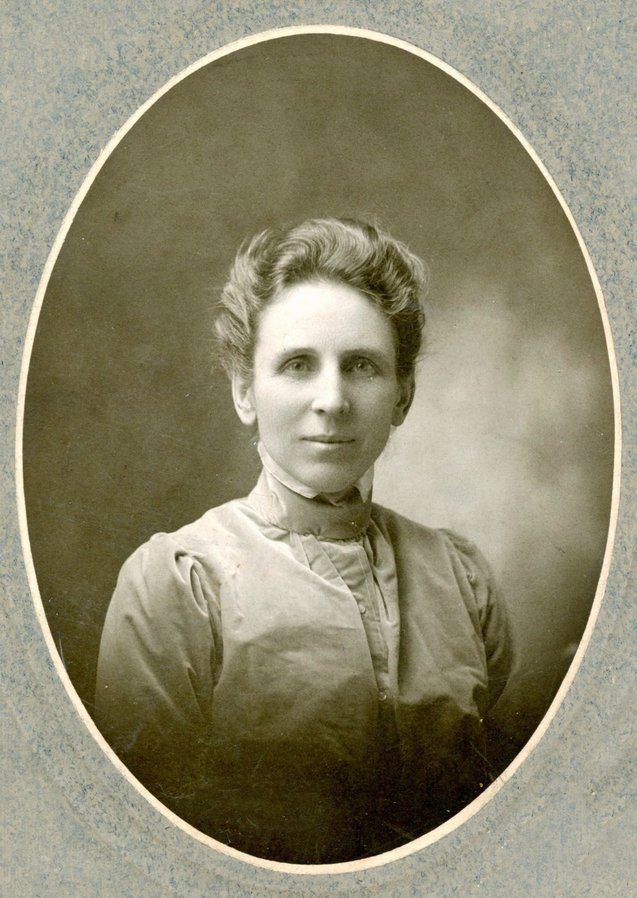 This portrait may be Alice Craig Peay, the mother of Alice Craig Gatchel, or it may be a portrait of Alice's Aunt Fanny Craig. From the Gatchel Family Collection, courtesy of Susan Lawson.
This portrait may be Alice Craig Peay, the mother of Alice Craig Gatchel, or it may be a portrait of Alice's Aunt Fanny Craig. From the Gatchel Family Collection, courtesy of Susan Lawson.
The Craigs maintained that Austin Peay died young and left his daughter an orphan. Alice was adopted and raised by her grandmother Annie Craig at Edgewood, located two doors down from Woodside on Central Avenue, and her last name was changed from Peay to Craig.
However, there's more to the story than the upstanding Craigs ever let on publicly. Austin Peay proved "the acorn doesn't fall far from the tree." Census and other records show he lived to the ripe old age of 75 and died in Ft. Worth, Texas on July 9, 1931.
The 1900 census shows he had supposedly married again, this time to Edith Kent. No official documentation of their marriage, however, has been found. Edith had two sons -- Ward and Walter Hubbard -- from a previous marriage. The family was living on 14th Avenue in Detroit, Michigan, and Austin was working in the insurance business. On December 27, 1900, the following story about Austin Peay ran in the Courier-Journal:
HELD ON FORGERY CHARGE
_____________________
Austin Peay, Formerly of Louisville.
In Trouble at Richmond, Mich.,
Over Discounted Notes
Mt. Clements, Mich., Dec. 26-- (Special) Something of a sensation was created in this county by the arrest of Austin Peay, formerly of Louisville, on a charge of forgery. Peay was agent for the Equitable Life Insurance Company and had lived in this (Macomb) county for the past year, where he had become prominent in social circles. Notes taken for premiums were discounted at the Macomb County Savings Bank, and officers at the bank discovered that one of the notes which Peay had paid himself had not been signed by the man whose signature it bore. An investigation followed, and it was discovered that another note of the same character was held by the bank.
Peay's arrest followed. He admitted his guilt and was bound over to the Circuit Court under $1,000 bond. Efforts made by his family to settle the trouble have been fruitless.
According to the "Eleventh Biennial Report of the Board of Control and Warden of the Michigan Reformatory at Ionia, Michigan," pg. 19, he was sentenced to 10 months for forgery on January 29, 1900, and was pardoned by the Governor H.S. Pingree on July 11, 1901. No wonder Annie Craig adopted her granddaughter! She was probably overjoyed to wash her hands of the scandal-mongering Peays.
In 1908, Austin resurfaced in Ft. Worth, Texas, where he married Alberta Wood on November 8. What became of his Detroit wife Edith Kent and her stepchildren has not been determined. By the 1920 census, he was living with Alberta at what appears to be a boarding house on Hilston Avenue in Ft. Worth and was back in the insurance business, despite his previous brush with the law in Michigan. Perhaps the pardon expunged his criminal record. His occupation was listed as a "policy writer for insurance company." A year prior to his death, he and his wife were running their own boarding house at 3713 Bunting Avenue, and Austin was working as an "insurance solicitor," according to the 1930 census.
However, there's more to the story than the upstanding Craigs ever let on publicly. Austin Peay proved "the acorn doesn't fall far from the tree." Census and other records show he lived to the ripe old age of 75 and died in Ft. Worth, Texas on July 9, 1931.
The 1900 census shows he had supposedly married again, this time to Edith Kent. No official documentation of their marriage, however, has been found. Edith had two sons -- Ward and Walter Hubbard -- from a previous marriage. The family was living on 14th Avenue in Detroit, Michigan, and Austin was working in the insurance business. On December 27, 1900, the following story about Austin Peay ran in the Courier-Journal:
HELD ON FORGERY CHARGE
_____________________
Austin Peay, Formerly of Louisville.
In Trouble at Richmond, Mich.,
Over Discounted Notes
Mt. Clements, Mich., Dec. 26-- (Special) Something of a sensation was created in this county by the arrest of Austin Peay, formerly of Louisville, on a charge of forgery. Peay was agent for the Equitable Life Insurance Company and had lived in this (Macomb) county for the past year, where he had become prominent in social circles. Notes taken for premiums were discounted at the Macomb County Savings Bank, and officers at the bank discovered that one of the notes which Peay had paid himself had not been signed by the man whose signature it bore. An investigation followed, and it was discovered that another note of the same character was held by the bank.
Peay's arrest followed. He admitted his guilt and was bound over to the Circuit Court under $1,000 bond. Efforts made by his family to settle the trouble have been fruitless.
According to the "Eleventh Biennial Report of the Board of Control and Warden of the Michigan Reformatory at Ionia, Michigan," pg. 19, he was sentenced to 10 months for forgery on January 29, 1900, and was pardoned by the Governor H.S. Pingree on July 11, 1901. No wonder Annie Craig adopted her granddaughter! She was probably overjoyed to wash her hands of the scandal-mongering Peays.
In 1908, Austin resurfaced in Ft. Worth, Texas, where he married Alberta Wood on November 8. What became of his Detroit wife Edith Kent and her stepchildren has not been determined. By the 1920 census, he was living with Alberta at what appears to be a boarding house on Hilston Avenue in Ft. Worth and was back in the insurance business, despite his previous brush with the law in Michigan. Perhaps the pardon expunged his criminal record. His occupation was listed as a "policy writer for insurance company." A year prior to his death, he and his wife were running their own boarding house at 3713 Bunting Avenue, and Austin was working as an "insurance solicitor," according to the 1930 census.
Frank Gatchel's Family Background
|
Frank Gatchel was a member of the family photography business, W.D. Gatchel & Sons. The firm was founded by his father, Welcome D. Gatchel (June 18, 1825-December 29, 1895). Family members used to say that his middle initial stood for “Darling,” making his name Welcome Darling Gatchel -- probably a tribute to his winning personality. (Editor's note: the D actually stood for Durfee.) "Pioneer Photographers from the Mississippi to the Continental Divide: A Biographical Dictionary, 1839-1865" by Peter E. Palmquist and Thomas R. Kailbourn (Stanford University Press, 2005) noted, "...An obituary in a photographic trade journal recalled (Welcome) Gatchel's 'loveliness of character, gentleness and integrity and probity.'"
Welcome married Frances Tripp (? -January 19, 1895) on March 19, 1856 in Farmington, NY. Frank was the youngest of their four children:
|
Portraits of Welcome D. Gatchel Through the Years
 Courier-Journal, November 12, 1897
Courier-Journal, November 12, 1897
It was his father's photography business that brought the family first to St. Louis, then to Cincinnati and then to Louisville, says this history of W.D. Gatchel & Sons from Historic Camera:
Born circa 1825, W. D. Gatchel became involved in the daguerreian trade while still in his early twenties when he entered into a partnership with Henry A. Hyatt. Together they opened a photographic stock dealership in St. Louis, Missouri in 1848. Thirteen years later, Mr. Gatchel met photographer R. P. Appleby, and shortly thereafter became manager of his photographic stock company. In 1863, he moved to Cincinnati, Ohio to manage the L. B. Darling company, and when Gatchel & Hyatt assumed the corporate reins, a branch was opened in Louisville, Kentucky, under the leadership of Mr. Hyatt.
Mr. Gatchel's photographic empire grew when his firm overtook William H. Tilford's St. Louis company and Mr. Merritt's Louisville, Kentucky business to form the Tri-City Stock House in 1873, which operated until 1881. At this time, Mr. Gatchel bought out Mr. Hyatt's interest in the Louisville company and returned to manage the Cincinnati stock house until selling it to Jordan and Sheen the following year. He and his family established permanent residence in Louisville in 1883, which is where Mr. Gatchel opened W. D. Gatchel & Sons. His great success in the photographic industry was attributed to his uncompromising integrity. Mr. Gatchel painstakingly provided his customers with the best products he could find. He also had a great appreciation for the creative side of portrait photography. Mr. Gatchel advised portrait photographers to study the art of posing so that their subjects would look natural rather than "stiff as a photograph." He emphasized the importance of perspective and of reminding the subject of the significance of a particular pose to the aesthetic appeal of the photograph. Such understanding, according to Mr. Gatchel, focused the subject's attention on the importance of the pose to the overall photograph and away from the focus of the camera lens. This resulted in a more relaxed posed instead of a stiff, statue-like posture that was common in many late nineteenth century photographs.
During the 1890s, Mr. Gatchel's health began to fail, and his sons, Albert and Frank began taking more active roles in the family business. W. D. Gatchel died at his Louisville home on December 29, 1895 at the age of 70. Albert D. and Frank Edwin Gatchel continued their father's commitment to quality, and were also active and well-respected members of the Louisville community.
On September 11th, after a short illness brought on by overwork, Albert D. Gatchel died.
The Gatchel family continued running the company until it ceased operations in 1990.
Born circa 1825, W. D. Gatchel became involved in the daguerreian trade while still in his early twenties when he entered into a partnership with Henry A. Hyatt. Together they opened a photographic stock dealership in St. Louis, Missouri in 1848. Thirteen years later, Mr. Gatchel met photographer R. P. Appleby, and shortly thereafter became manager of his photographic stock company. In 1863, he moved to Cincinnati, Ohio to manage the L. B. Darling company, and when Gatchel & Hyatt assumed the corporate reins, a branch was opened in Louisville, Kentucky, under the leadership of Mr. Hyatt.
Mr. Gatchel's photographic empire grew when his firm overtook William H. Tilford's St. Louis company and Mr. Merritt's Louisville, Kentucky business to form the Tri-City Stock House in 1873, which operated until 1881. At this time, Mr. Gatchel bought out Mr. Hyatt's interest in the Louisville company and returned to manage the Cincinnati stock house until selling it to Jordan and Sheen the following year. He and his family established permanent residence in Louisville in 1883, which is where Mr. Gatchel opened W. D. Gatchel & Sons. His great success in the photographic industry was attributed to his uncompromising integrity. Mr. Gatchel painstakingly provided his customers with the best products he could find. He also had a great appreciation for the creative side of portrait photography. Mr. Gatchel advised portrait photographers to study the art of posing so that their subjects would look natural rather than "stiff as a photograph." He emphasized the importance of perspective and of reminding the subject of the significance of a particular pose to the aesthetic appeal of the photograph. Such understanding, according to Mr. Gatchel, focused the subject's attention on the importance of the pose to the overall photograph and away from the focus of the camera lens. This resulted in a more relaxed posed instead of a stiff, statue-like posture that was common in many late nineteenth century photographs.
During the 1890s, Mr. Gatchel's health began to fail, and his sons, Albert and Frank began taking more active roles in the family business. W. D. Gatchel died at his Louisville home on December 29, 1895 at the age of 70. Albert D. and Frank Edwin Gatchel continued their father's commitment to quality, and were also active and well-respected members of the Louisville community.
On September 11th, after a short illness brought on by overwork, Albert D. Gatchel died.
The Gatchel family continued running the company until it ceased operations in 1990.
Pages from Frank Gatchel's 1892 Autograph Book While the Family Was Living in Cincinnati, Courtesy Susan Lawson
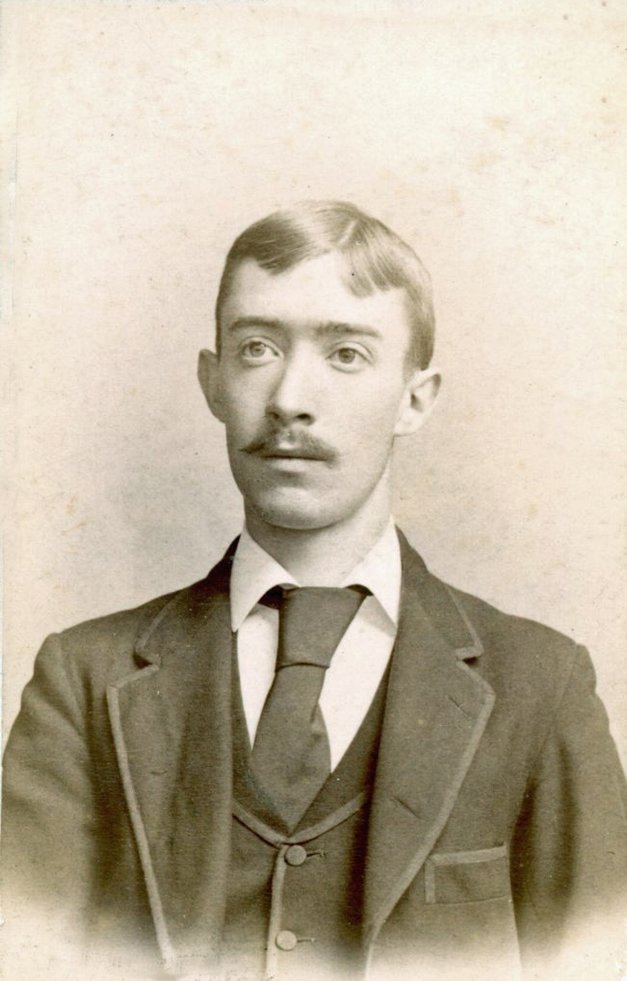 Frank Gatchel as a young man
Frank Gatchel as a young man
After opening their Louisville store, the family lived first lived at 1042 4th Street and later moved to at 1125 2nd Street, which was where they were living when W.D. Gatchel died in 1896. Their photography shop was located at 89 Jefferson Street, near Third, in 1873, when they bought out Hyatt. By 1884, the store's address was 327 W. Jefferson and by 1895, it had moved to 343-345 W. Jefferson. Later, it was located at Fifth & Walnut.
In 1887, W.D. Gatchel's went into partial receivership as the result of bad investments. The story was covered by the July 2, 1887 New York Times:
FAILURES IN LOUISVILLE
LOUISVILLE, Ky. July 1 -- W.D. Gatchel, proprietor of the photographers' supply business, at 328 W. Jefferson-street, made an assignment for the benefit of his creditors this morning. Mr. Gatchel says he was pulled down by the break of the Fidelity Bank, of Cincinnati. He was a personal friend of Hopkins, the Assistant Cashier, and through his misrepresentations was induced to purchase stock and to lend money on notes of the bank. His wife and two sons also held stock in it at the time it went under. His liabilities will not exceed $25,000, and he thinks he will be able to effect a compromise.
It was also covered by the July 2, 1887 Courier-Journal:
CRASHES IN BUSINESS
_________________________
...A Photographer's Supply House Ruined
By the Failure of the Fidelity
Bank
________________________
...W.D. Gatchel Assigns
W.D. Gatchel, doing business in pictures, picture frames, and general photographer's supplies, on Jefferson street, between Third and Fourth, made a general assignment yesterday for the benefit of his creditors. His deed it to Harry Stackey. He gives up all merchandise and fixtures in the store, and all choses in action, besides a piece of property in Oxana, Calhoun County, Ala. The schedules of his estate were not filed, but the assets and liabilities are both small. The indebtedness is mostly to Eastern firms.
Mr. Gatchel and his sons lost several thousand dollars in the recent Fidelity Bank failure at Cincinnati, and this probably precipitated the failure.
Frank graduated from Yale University in June 1893 and came back to Louisville to work in the family business with his father and older brother, Bert. Apparently, the firm was still experiencing financial problems. In December 1894, the family home on Second Street was put up for auction by Jefferson County Sheriff Henry A. Bell for non-payment of property taxes. Frank managed to come up with the money, because two years later he bought out his sister's two-thirds interest in the the house for $4,333.
According to John Cleaver Gatchel, who later ran the company for 20+ years (ca. 1970 to 1990), Frank served as president in Louisville, and his brother Bert, who married Caroline Letitia Forwood or “Daisy,” in January 1890, moved to Birmingham, Alabama for a time and established another branch for the company there known as Gatchel’s Photo Stock House.
In 1887, W.D. Gatchel's went into partial receivership as the result of bad investments. The story was covered by the July 2, 1887 New York Times:
FAILURES IN LOUISVILLE
LOUISVILLE, Ky. July 1 -- W.D. Gatchel, proprietor of the photographers' supply business, at 328 W. Jefferson-street, made an assignment for the benefit of his creditors this morning. Mr. Gatchel says he was pulled down by the break of the Fidelity Bank, of Cincinnati. He was a personal friend of Hopkins, the Assistant Cashier, and through his misrepresentations was induced to purchase stock and to lend money on notes of the bank. His wife and two sons also held stock in it at the time it went under. His liabilities will not exceed $25,000, and he thinks he will be able to effect a compromise.
It was also covered by the July 2, 1887 Courier-Journal:
CRASHES IN BUSINESS
_________________________
...A Photographer's Supply House Ruined
By the Failure of the Fidelity
Bank
________________________
...W.D. Gatchel Assigns
W.D. Gatchel, doing business in pictures, picture frames, and general photographer's supplies, on Jefferson street, between Third and Fourth, made a general assignment yesterday for the benefit of his creditors. His deed it to Harry Stackey. He gives up all merchandise and fixtures in the store, and all choses in action, besides a piece of property in Oxana, Calhoun County, Ala. The schedules of his estate were not filed, but the assets and liabilities are both small. The indebtedness is mostly to Eastern firms.
Mr. Gatchel and his sons lost several thousand dollars in the recent Fidelity Bank failure at Cincinnati, and this probably precipitated the failure.
Frank graduated from Yale University in June 1893 and came back to Louisville to work in the family business with his father and older brother, Bert. Apparently, the firm was still experiencing financial problems. In December 1894, the family home on Second Street was put up for auction by Jefferson County Sheriff Henry A. Bell for non-payment of property taxes. Frank managed to come up with the money, because two years later he bought out his sister's two-thirds interest in the the house for $4,333.
According to John Cleaver Gatchel, who later ran the company for 20+ years (ca. 1970 to 1990), Frank served as president in Louisville, and his brother Bert, who married Caroline Letitia Forwood or “Daisy,” in January 1890, moved to Birmingham, Alabama for a time and established another branch for the company there known as Gatchel’s Photo Stock House.
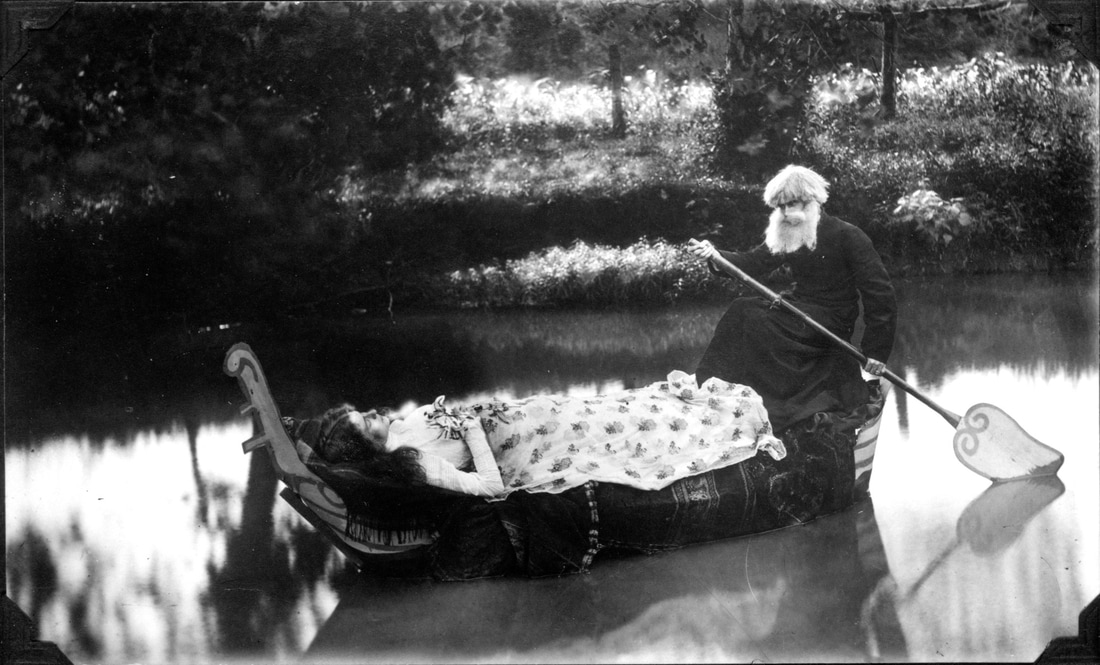
This Kate Matthews tableau entitled, "Elaine, lily maid of Astolat," shows Mary Johnston as Elaine. The boatman is either Bert Gatchel or Kate Matthews dressed as a man. From the Richard N. Duncan Collection.
A profile of the business appeared in "Louisville of today," a souvenir book of the city of Louisville distributed during the G.A.R. (Grand Army of the Republic) encampment held in Louisville in 1895:
W.D. GATCHEL & SONS: Photo, Goods and Picture Frames; Nos. 343 and 345 West Jefferson Street. -- This extensive business was established in 1865, by Mr. W.D. Gatchel, who is now assisted by his sons A.D. and F.E. Gatchel, young men of great energy and business ability. They are active managers of the business, which is the oldest of the kind in Louisville. In 1890, Mr. A.D. Gatchel opened a branch in Birmingham, Ala., at No. 214 Twenty-first Street. The salesrooms in this city comprise a spacious first floor 25x100 feet in areas, fitted up with every convenience for the extensive and valuable stock, where both the professional and amateur can best select what will meet their requirements. Here can be obtained all sizes of cameras, lenses, dry plates, posing chairs, photo paper, field outfits, picture frames, etc. Orders are carefully filled and the trade of the house, which is steadily increasing extends from Allegheny Mountains to the Mississippi River, and from the Ohio River to the Gulf of Mexico. Mr. W.D. Gatchel was born in New York state, and has been in this business at both Cincinnati and Louisville. The members of the firm are honorable and liberal businessmen, who are fully alive to the progress of the photographic art, and their success in this industry is as marked, as it is well deserved.
W.D. GATCHEL & SONS: Photo, Goods and Picture Frames; Nos. 343 and 345 West Jefferson Street. -- This extensive business was established in 1865, by Mr. W.D. Gatchel, who is now assisted by his sons A.D. and F.E. Gatchel, young men of great energy and business ability. They are active managers of the business, which is the oldest of the kind in Louisville. In 1890, Mr. A.D. Gatchel opened a branch in Birmingham, Ala., at No. 214 Twenty-first Street. The salesrooms in this city comprise a spacious first floor 25x100 feet in areas, fitted up with every convenience for the extensive and valuable stock, where both the professional and amateur can best select what will meet their requirements. Here can be obtained all sizes of cameras, lenses, dry plates, posing chairs, photo paper, field outfits, picture frames, etc. Orders are carefully filled and the trade of the house, which is steadily increasing extends from Allegheny Mountains to the Mississippi River, and from the Ohio River to the Gulf of Mexico. Mr. W.D. Gatchel was born in New York state, and has been in this business at both Cincinnati and Louisville. The members of the firm are honorable and liberal businessmen, who are fully alive to the progress of the photographic art, and their success in this industry is as marked, as it is well deserved.
Both Welcome and his wife Frances died in 1895. Frances passed away on January 19th at their Second Street home, after a short bout with pneumonia. Welcome died in December, but had been ill for some time, according to the December 30, 1895 Courier-Journal:
W.D. Gatchel is very ill at his residence, on Second street, and his death is expected. He has been in failing health for a year or more, and paralysis was precipitated by an attack of dysentery ten days ago. His children are at his bedside.
He died later that night. The January 1, 1896 Courier-Journal carried his funeral announcement:
The funeral services of the late W.D. Gatchel, who died Sunday night, will take place this morning at the family residence, 1125 Second street. The Rev. Dr. S.M. Hamilton will officiate. The pall bearers will be Messrs. Geo. F. Wood, J.G. Weller, Jas. Davidson, H.C. Warren, H.V. Loving and S.L. Avery. The internment will be in Cave Hill.
W.D. Gatchel is very ill at his residence, on Second street, and his death is expected. He has been in failing health for a year or more, and paralysis was precipitated by an attack of dysentery ten days ago. His children are at his bedside.
He died later that night. The January 1, 1896 Courier-Journal carried his funeral announcement:
The funeral services of the late W.D. Gatchel, who died Sunday night, will take place this morning at the family residence, 1125 Second street. The Rev. Dr. S.M. Hamilton will officiate. The pall bearers will be Messrs. Geo. F. Wood, J.G. Weller, Jas. Davidson, H.C. Warren, H.V. Loving and S.L. Avery. The internment will be in Cave Hill.
Advertisments for W.D. Gatchel & Sons: 1899-1922
In 1901, W.D. Gatchel & Sons suffered another setback, when a fire broke out at their next-door competitor's store, the Badgley-Graham Company, at 345 W. Jefferson. Two people were killed and five firemen were injured, according to this page-two story from the July 28, 1901 Courier-Journal:
With an explosion that was heard for squares and was followed a second later be a sweeping mass of flame, fire broke out in the photographic supply store of the Badgley Graham Co., Inc., 349 West Jefferson street, at 11 o'clock last night. Before its career was checked, two lives were lost and property valued at $30,000 to $35,000 was destroyed.
The firms that suffered were the Badgley-Graham Co., whose loss was $8,500, fully insured; W.D. Gatchel & Sons, loss $5,500, with $4,800 insurance; Stewart Dry Goods Company, about $12,000, fully insured; and The Creamerie Restaurant, loss $1,000.
While there have been more disastrous fires in Louisville, few have been attended with as dramatic incidents. The streets at the time of the time of the first explosion were crowded with people going home from their Saturday night shopping. The sound was deafening and the shock that came with it threw many from their feet. Then in quick succession report followed report and with each the flames grew brighter and swept forward with an added strength. It seemed that the very buildings would be wrecked by the power of these explosions. There was no time for explanation.
******
All the Department There
__________
The alarm went in from box 42. Before the first engine dashed in a run, the second alarm was rung, and the full force of the department was on the scene within five minutes. Short as was the space of time, the flames had eaten through the second and third stories of the Badgley-Graham Co. The wall between Badgley-Graham and W.D. Gatchel's, next door, went down in a crumbling heap, and the flames started in on the work of destruction.
******
New Series of Explosions
___________
Then began a new series of explosions as the oils and benzine of the Gatchel Photographic Supply Company felt the influence of the flames. The flames in their sideward course were stopped by the fireproof wall of the Stewart Dry Goods Company, and burning stright in from Jefferson street, swept through the two stores in a direct line. Then swerving again, they turned in through the L of the Stewart's Dry Goods Company and played havoc with the supply of fine laces, silks and millinery stores in that part of the building.
******
First Water on the Fire
___________
By this time three lines of hose were playing through the photographic supply stores. Firemen had clambered up the roofs and into the windows on the third floor and were calling for ladders to be run into them. Headed by the Salvage Corps, a group of firemen ran the length of the New York Store and a stream of water went through the side of the building already worn thin by the flames that were beginning to creep in through the windows and walls.
Still a fourth gang of men, beating through doors and climbing stairways, dragging long lines of hose behind them, had fought their way out to the roof of Gatchel's and were throwing a full stream down into the flames below them and those that were almost abreast of them as they broke their way at last through the roof of the Badgley-Graham Co. store. In front three streams of water played almost ceaselessly on the fire that still burned firecely in the two photographic supply stores. Fortunately, the noise of the explosion had given the great majority of people who lived over these stores a chance to escape.
******
Went to the Rescue of the Residents
___________
In spite of the danger and almost absolute certainty that they were aware of their danger, the men dashed up the stairway between the Stewart Dry Good Company's store and that of Gatchel, beating at the doors and dragging from the rooms all those who were not dashing past them in a wild stream for the street. Soon, men, women and children poured down the one stairway, huddled for a moment on the street outside, and were then almost carried by the crowd, which has grown to thousands, to places of safety at the corner of Third and Jefferson streets....
******
....Went to the Rescue of the Residents
___________
Dr. E.L. Sanders, who has a flat above Gatchel's, had gone away, leaving his wife alone. Half-crazed by the thought of her danger, he led a search party throughout the house. No trace of the woman was found, and Dr. Sanders dashed from the house, only to run into the arms of a friend, who told him that his wife had made her escape.
******
....Captain Lehan Injured
___________
Up to this time, there had been but one slight accident, Capt. Tim Lehan, of Engine Company No. 2, had been cut by falling glass and had been carried out into the street. He was soon revived and went back to his post....
******
....First Victim Brought Out
___________
Then down the stairway that leads over Gatchel's, came Capt. Dillard, Gregory Sheelran and James P. Wallace, of Engine Company No. 4, and Assistant Chief Tully bringing with them the body of Max Belovitch. They staggered to the foot of the stairway and the blackened body was placed on the ground...
******
....Then Patrolman Purdon's Body
___________
...Another group of men came down the fatal stairway bearing the body of Patrolman Purdon, which had been found not ten feet from that of Belovitch. Both were discovered in the last room of the third floor over Gatchel's store...
******
....Three Firemen Carried Out
___________
While the bodies of Belovitch and Purdon were being carried to the hospital, the cry went up that four men were dead, and there seemed to be cause for it. Hardly had the ambulances started on their way when out from the floor of the Gatchel Company three firemen were borne. From the breast and shoulders of one the blood was flowing in streams. The other two hung limp and seemingly lifeless from the arms of the men who carried them.
A brief examination showed that two were overcome by smoke and heat and that the third had been hurt by falling glass. Harry Swain, in an effort to get through the Gatchel building, had been struck by glass in one of the windows in the rear as it was crushed and splintered under a full stream of water.
Charles Bowser and Fred Keller were overcome by the smoke and heat while trying to rescue him, and all three were brought in safety under a search patrol sent out by Chief Hughes.
******
Origin Is Not Clear
___________
The origin of the fire is not wholly clear. Some of those who escaped from the flats above the burning stores declared that for four hours before the explosion they had smelt the fumes of burning rags and trash.
It is supposed by some that some one set fire carelessly to a pile of trash that had accumulated in the little vacant space in the rear of the Badley-Graham Co. and Gatchel stores, and that sparks from this fire made their way through the wide cellar gratings of the Badgley-Graham Co. and reached the barrels of benzine and photographic oils. This is believed to have caused the first explosion and set fire to the building.
The flames burst out in all directions, and this explains the incredibly short time in which the flames gathered such headway.
******
Ready Food For the Flames
___________
The store occupied by Gatchel & Sons with filled with the same inflammable and explosive material as Badgley-Graham's, offering the best material possible to increase the force and power of the flames. The situation from the first was one of the gravest menace and only the promptest and most heroic work of every member of the fire department saved the greater part of the block from burning. Every man showed himself a hero, going into and holding places of danger without question or the thought of himself.
The block in which the fire occurred was owned by the Tyler estate, of which Owen Tyler is trustee. Last night it was impossible to learn from Mr. Tyler the full extent of the damage to the property. The entire stock of the Badgley-Graham Company, valued at $8,500, was destroyed. It was fully covered by insurance. Mr. W.D. Gatchel, of Gatchel and Sons, (editor's note: W.D. died in 1895, so the estimate came from either Frank or Bert) which was completely ruined, at $5,500, with an insurance of $4,800.
The largest loss was to the Stewart's Dry Goods Company, the smoke, fire and water playing havoc with its silks and laces. The damage is put at between $10,000 and $15,000. The entire stock is insured for $300,000,
The walls and ceiling of the Creamerie restaurant, just west of the Badgley, Graham & Co., were drenched with water and blackened with smoke. Its furnishings were seriously damaged by the same agencies, but it is doubtful if the loss will exceed $1,000...
With an explosion that was heard for squares and was followed a second later be a sweeping mass of flame, fire broke out in the photographic supply store of the Badgley Graham Co., Inc., 349 West Jefferson street, at 11 o'clock last night. Before its career was checked, two lives were lost and property valued at $30,000 to $35,000 was destroyed.
The firms that suffered were the Badgley-Graham Co., whose loss was $8,500, fully insured; W.D. Gatchel & Sons, loss $5,500, with $4,800 insurance; Stewart Dry Goods Company, about $12,000, fully insured; and The Creamerie Restaurant, loss $1,000.
While there have been more disastrous fires in Louisville, few have been attended with as dramatic incidents. The streets at the time of the time of the first explosion were crowded with people going home from their Saturday night shopping. The sound was deafening and the shock that came with it threw many from their feet. Then in quick succession report followed report and with each the flames grew brighter and swept forward with an added strength. It seemed that the very buildings would be wrecked by the power of these explosions. There was no time for explanation.
******
All the Department There
__________
The alarm went in from box 42. Before the first engine dashed in a run, the second alarm was rung, and the full force of the department was on the scene within five minutes. Short as was the space of time, the flames had eaten through the second and third stories of the Badgley-Graham Co. The wall between Badgley-Graham and W.D. Gatchel's, next door, went down in a crumbling heap, and the flames started in on the work of destruction.
******
New Series of Explosions
___________
Then began a new series of explosions as the oils and benzine of the Gatchel Photographic Supply Company felt the influence of the flames. The flames in their sideward course were stopped by the fireproof wall of the Stewart Dry Goods Company, and burning stright in from Jefferson street, swept through the two stores in a direct line. Then swerving again, they turned in through the L of the Stewart's Dry Goods Company and played havoc with the supply of fine laces, silks and millinery stores in that part of the building.
******
First Water on the Fire
___________
By this time three lines of hose were playing through the photographic supply stores. Firemen had clambered up the roofs and into the windows on the third floor and were calling for ladders to be run into them. Headed by the Salvage Corps, a group of firemen ran the length of the New York Store and a stream of water went through the side of the building already worn thin by the flames that were beginning to creep in through the windows and walls.
Still a fourth gang of men, beating through doors and climbing stairways, dragging long lines of hose behind them, had fought their way out to the roof of Gatchel's and were throwing a full stream down into the flames below them and those that were almost abreast of them as they broke their way at last through the roof of the Badgley-Graham Co. store. In front three streams of water played almost ceaselessly on the fire that still burned firecely in the two photographic supply stores. Fortunately, the noise of the explosion had given the great majority of people who lived over these stores a chance to escape.
******
Went to the Rescue of the Residents
___________
In spite of the danger and almost absolute certainty that they were aware of their danger, the men dashed up the stairway between the Stewart Dry Good Company's store and that of Gatchel, beating at the doors and dragging from the rooms all those who were not dashing past them in a wild stream for the street. Soon, men, women and children poured down the one stairway, huddled for a moment on the street outside, and were then almost carried by the crowd, which has grown to thousands, to places of safety at the corner of Third and Jefferson streets....
******
....Went to the Rescue of the Residents
___________
Dr. E.L. Sanders, who has a flat above Gatchel's, had gone away, leaving his wife alone. Half-crazed by the thought of her danger, he led a search party throughout the house. No trace of the woman was found, and Dr. Sanders dashed from the house, only to run into the arms of a friend, who told him that his wife had made her escape.
******
....Captain Lehan Injured
___________
Up to this time, there had been but one slight accident, Capt. Tim Lehan, of Engine Company No. 2, had been cut by falling glass and had been carried out into the street. He was soon revived and went back to his post....
******
....First Victim Brought Out
___________
Then down the stairway that leads over Gatchel's, came Capt. Dillard, Gregory Sheelran and James P. Wallace, of Engine Company No. 4, and Assistant Chief Tully bringing with them the body of Max Belovitch. They staggered to the foot of the stairway and the blackened body was placed on the ground...
******
....Then Patrolman Purdon's Body
___________
...Another group of men came down the fatal stairway bearing the body of Patrolman Purdon, which had been found not ten feet from that of Belovitch. Both were discovered in the last room of the third floor over Gatchel's store...
******
....Three Firemen Carried Out
___________
While the bodies of Belovitch and Purdon were being carried to the hospital, the cry went up that four men were dead, and there seemed to be cause for it. Hardly had the ambulances started on their way when out from the floor of the Gatchel Company three firemen were borne. From the breast and shoulders of one the blood was flowing in streams. The other two hung limp and seemingly lifeless from the arms of the men who carried them.
A brief examination showed that two were overcome by smoke and heat and that the third had been hurt by falling glass. Harry Swain, in an effort to get through the Gatchel building, had been struck by glass in one of the windows in the rear as it was crushed and splintered under a full stream of water.
Charles Bowser and Fred Keller were overcome by the smoke and heat while trying to rescue him, and all three were brought in safety under a search patrol sent out by Chief Hughes.
******
Origin Is Not Clear
___________
The origin of the fire is not wholly clear. Some of those who escaped from the flats above the burning stores declared that for four hours before the explosion they had smelt the fumes of burning rags and trash.
It is supposed by some that some one set fire carelessly to a pile of trash that had accumulated in the little vacant space in the rear of the Badley-Graham Co. and Gatchel stores, and that sparks from this fire made their way through the wide cellar gratings of the Badgley-Graham Co. and reached the barrels of benzine and photographic oils. This is believed to have caused the first explosion and set fire to the building.
The flames burst out in all directions, and this explains the incredibly short time in which the flames gathered such headway.
******
Ready Food For the Flames
___________
The store occupied by Gatchel & Sons with filled with the same inflammable and explosive material as Badgley-Graham's, offering the best material possible to increase the force and power of the flames. The situation from the first was one of the gravest menace and only the promptest and most heroic work of every member of the fire department saved the greater part of the block from burning. Every man showed himself a hero, going into and holding places of danger without question or the thought of himself.
The block in which the fire occurred was owned by the Tyler estate, of which Owen Tyler is trustee. Last night it was impossible to learn from Mr. Tyler the full extent of the damage to the property. The entire stock of the Badgley-Graham Company, valued at $8,500, was destroyed. It was fully covered by insurance. Mr. W.D. Gatchel, of Gatchel and Sons, (editor's note: W.D. died in 1895, so the estimate came from either Frank or Bert) which was completely ruined, at $5,500, with an insurance of $4,800.
The largest loss was to the Stewart's Dry Goods Company, the smoke, fire and water playing havoc with its silks and laces. The damage is put at between $10,000 and $15,000. The entire stock is insured for $300,000,
The walls and ceiling of the Creamerie restaurant, just west of the Badgley, Graham & Co., were drenched with water and blackened with smoke. Its furnishings were seriously damaged by the same agencies, but it is doubtful if the loss will exceed $1,000...
Two years later, on November 23, 1903, Badgley-Graham burned again, this time at their new location at the Masonic Temple. W.D. Gatchel and Sons paid $1,050 for their good will, orders, and other business, according to the December 6, 1903 Courier-Journal. The deal barred their former competitor from doing business in Louisville for five years.
The Wedding of Alice Craig and Frank Gatchel
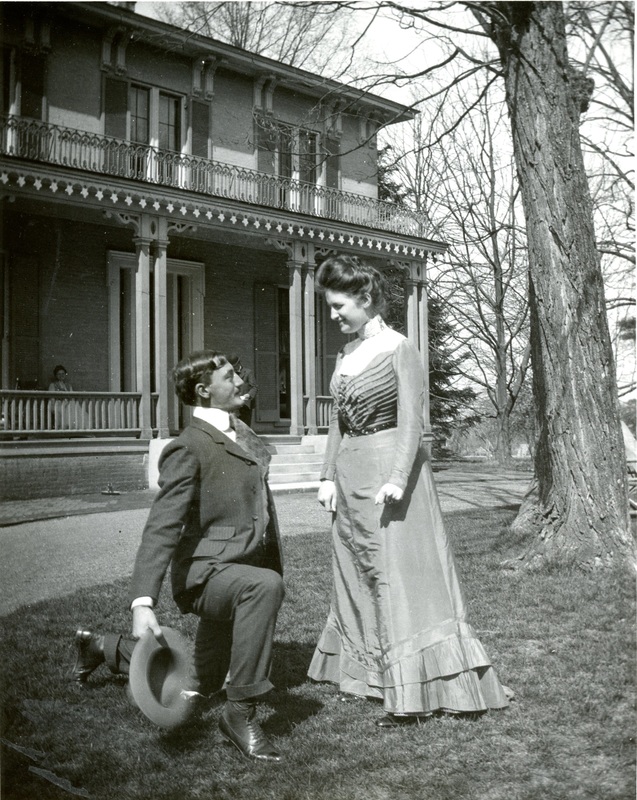 Frank Gatchel proposing to Alice Craig Peay in front of Edgewood, where she was raised by her grandmother Annie Craig and Aunt Fannie Craig after her mother died.
Frank Gatchel proposing to Alice Craig Peay in front of Edgewood, where she was raised by her grandmother Annie Craig and Aunt Fannie Craig after her mother died.
Alice's engagement to Frank was announced at a dinner held at the Louisville home of her aunt and uncle Samuel and Louise Culbertson. The occasion was actually held to mark another engagement, according to this newspaper story clipped from the December 28, 1902 Courier-Journal in the Gatchel family collection donated by Susan Lawson:
Mr. and Mrs. Samuel A. Culbertson gave a handsome dinner party last evening in honor of Katharyn Cox and Mr. Edwin Gheens, who will be married in April.
Much to the surprise of all the guests present the entertainment was the occasion for the announcement of an engagement which will prove a most interesting bit of news for society this morning -- that of Mrs. Culbertson's niece, Miss Alice Craig, and Mr. Frank E. Gatchel.
It was a complete surprise for all except the closest friends of the young people, and will add another to the list of early spring weddings.
It was something of a coincidence that the initial letter of the first names of both the guests of honor, Miss Cox and Mr. Gheens, should be the same as those of Miss Craig and Mr. Gatchel, and therefore the monograpm "G.-C." had no further significance for the guests than standing for Gheens-Cox.
The wedding bell above the table, the heart-shape of the cakes, ices and confections were all appropriate for an engagement announcement-dinner, as well as for one given an honor of an approaching bride and groom, and were also not tell-tale. Therefore, when the announcement was made during the evening, it was a most unexpected piece of news...
...The party included the following: Mr. and Mrs. S.A. Culbertson, Mr. and Mrs. Attilla Cox, Mr. and Mrs. Charles Gheens; Misses Katharyn Cox, Jane Helm, Alice Craig, Lura Chess; Messrs. Edwin Gheens, Marshall Bullitt, Frank Gatchel, J.W. Gaulbert.
On April 14, 1903, the couple married at the Pewee Valley Presbyterian Church. The Courier-Journal published the following story about their wedding the next day.
BEAUTIFUL WEDDING AT PEWEE VALLEY
Miss Alice Craig Becomes the Bride of Mr. Frances Gatchel of Louisville
Pewee Valley, Kentucky, April 14 --(Special)--The most beautiful wedding witnessed here for a number of years was that of Miss Alice Craig, of this place, and Mr. Francis Gatchel of Louisville, which was solemnized here at the Presbyterian Church at noon. The ceremony was performed by Rev. C.M. Creighton, pastor of the church, before a large congregation of friends and relatives of the bride and groom.
The Louisville guests arrived on a special car at 11:55 o'clock and were taken immediately to the church. The ceremony was preceded by a beautiful musical programme, including the "Lohengrine Bridal Chorus" sung by Miss Alice Muldoon of Louisville. The bridal party advanced to the alter at the opening notes of "Faithful and true," of the beautiful chorus. The groom and his best man, Mr. Lafon Allen, came first; Mr. Sam Bland alone; Mr. Bert Gatchel and Mr. Arthur Allen came together. Then Miss Lura Chess came alone; Miss Jane Helm and Miss Grace Chess together. Then the two little flower girls, Catherine and Louise Lawton, came, being followed immediately by the bride and her matron of honor, Mrs. Samuel Culbertson, of Louisville. The bride carried lilies of the valley, and the bridesmaids carried white lilacs. During the ceremony, "Oh Tender Moon" from "Faust" was played and the bridal party went out to Mendelssohn. The bridal party and a large party of friends were entertained at breakfast at the home of Mrs. Annie Craig immediately after the ceremony at the church. The church was simply but beautifully decorated with white lilacs, apple blossoms, and potted plants.
Mr. and Mrs. Gatchel left on the 2 o'clock train and upon their return from a bridal tour will keep house at 916 Second street, Louisville.
Alice's Death
|
Frank and Alice had two children:
Neither Bert nor Frank was destined to enjoy a long marriage. Bert’s wife Daisy died of typhoid fever shortly after the couple moved to Birmingham. He himself died in 1912 in Louisville, and his obituary ran in the September 12, 1912 Courier-Journal: The funeral of Albert D. Gatchel, who died at his residence, 1319 Everett avenue, at 1:30 o'clock yesterday afternoon, will be held at 4 o'clock tomorrow afternoon. Interment will be in Cave Hill Cemetery. Some weeks ago Mr. Gatchel was stricken with a severe fever, and his removal to Jewish Hospital was considered necessary. The patient became worse, and brain trouble developed. After being taken back to his residence, he lingered several weeks. Mr. Gatchel was a native of Chicago, lived for a time in Cincinnati, and thirty years ago removed to Louisville. He was associated with his brother in the photographic stock business in Jefferson street, near Fourth avenue. He is survived by his brother, F.E. Gatchel, and a sister, Mrs. M.G. Wilson. Alice died on March 8, 1908 of childbirth fever, leaving behind a bereaved husband and two young children. Her obituary ran in the Courier-Journal on March 9, 1908: HAND OF DEATH LAID UPON MRS. ALICE CRAIG GATCHEL ________________________ Wife of Frank E. Gatchel Succombs At her Home in Pewee Valley After Short Illness Mrs. Alice Craig Gatchel, wife of F.E. Gatchel, of the firm W.D. Gatchel & Sons, the photographer's supply house at 412 West Jefferson street, succumbed to a complication of diseases yesterday morning at 10:30 o'clock at her home in Pewee Valley. Mrs. Gatchel had been ill since the birth of a child last week, Sunday. For several days she had suffered from peritonitis, which proved fatal. Her condition, while serious, did not assume a critical aspect until about two days ago, when she grew worse and sank steadily until the end came yesterday morning surrounded by members of her family. Mrs. Gatchel was 25 years of age and a native of Pewee Valley, where she had lived all of her life. |
|
Before her marriage she was Miss Alice Craig, a niece of Merton Craig, of Mrs. Samuel A. Culbertson, and of Mrs. Henry Lawton, wife of Gen. Lawton, of Pewee Valley. Mrs. Gatchel was one of the best-known women in Louisville, and made her debut here several years ago. She became the wife of Mr. Gatchel five years ago, and for a year after their marriage lived in Louisville, but later moved to Pewee Valley, where they have since resided. She leaves two children, the oldest of which is Frances, age 4. Her grandmother, Mrs. Annie Craig, also survives.
The funeral services will be held at 9:45 o'clock to-morrow morning at the Pewee Valley Presbyterian Church, and the burial will be in Cave Hill Cemetery. Those wishing to attend the funeral should take the 8:30 a.m. car from the city or join the family at 11:25 a.m. at the gates of Cave Hill Cemetery.
According to "The United Presbyterian Church in Pewee Valley 1866-1966 100th Anniversary" booklet, an Aeolian organ was given to the church by her cousin, William Culbertson, in her memory.
Photos from the Gatchel Family Collection, Courtesy Susan Lawson
Biographical Sketch of Frank Gatchel
Frank provided a biographical sketch of his life's accomplishments during the first quarter century after his college graduation for the "Twenty-five Year Record, Class of Ninety-three, Yale College: Including an Account of the Anniversary Reunion in June, 1918," published by Yale University, Class of 1893, Noah Hayes Swayne (Morehouse & Taylor Company, 1918):
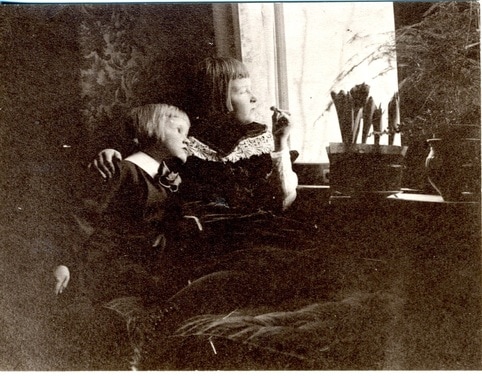 Kate Matthews photograph of Frances and Billy Gatchel. Courtesy Ed Shadburn.
Kate Matthews photograph of Frances and Billy Gatchel. Courtesy Ed Shadburn.
Frank Gatchel was born November 3, 1869 in Cincinnati, Ohio, and was prepared at the Louisville Male High School, Professor Chenault's private school and at Phillips-Andover. In college he received second colloquy appointments, was class historian and a member of the Andover Club, University Club, University Drum Corps, University Banjo Club and Alpha Delta Phi.
After graduation he entered his father's business, W.D. Gatchel & Sons, dealer in photographic supplies. Since the death of his brother in 1912 he has been the sole proprietor.
He is a Republican in politics but "voted for Wilson and strong for him." He is a deacon and treasurer of the Presbyterian Church.
He was married April 14, 1903, in Pewee Valley, Kentucky, to Alice Craig, daughter of Austin and Alice (Craig) Peay. Left an orphan as a child, she was formally adopted by her grandmother and took her mother's name of Alice Craig. They had two children: Frances Craig, born April 1, 1904, and William Culbertson, born March 1, 1908.
Gatchel writes: "At last I have been up in the attic, while the thermometer was hovering near zero, and on a 'heatless Monday' at that, and have been down to the bottom of a trunk filled with old family albums, books and war time collections of illustrated papers, and got out the old family Bible. The attic was just as cold as it is pictured in melodramas and had I not become a disciple of Zoroaster, after this long, hard winter, I would never have had the courage to go up there without my arctics and sleeping bag.
"Had it all planned to retire at forty and be a devil of a fellow thereafter.
"Something skidded along the route and I moved to a suburb seventeen miles from the city. Resigned from the club. Never joined any fraternal orders as I did not have time to go out at nights. For the past twelve years have been raising two very fine children and what with these responsibilities and the entire charge of the business for the past six years, I have not had time for outside interests or recreations. Took a vacation twelve years ago, in Florida, and it has lasted me ever since. But it was a dandy trip. Living out in the country, I find recreation and relaxation working about the place and playing with the kids, and after all that is just about the best sport I know of.
"Of course, I have been in all the daily civic movements like Boy Scout campaigns, Red Cross, Liberty Bond and many charitable and civic improvement campaigns, But I have never accepted office nor taken up the management that would require time away from home, so do not feel they should be mentioned.
"Sorry I have not pulled off some big league stuff for the honor of the class."
After graduation he entered his father's business, W.D. Gatchel & Sons, dealer in photographic supplies. Since the death of his brother in 1912 he has been the sole proprietor.
He is a Republican in politics but "voted for Wilson and strong for him." He is a deacon and treasurer of the Presbyterian Church.
He was married April 14, 1903, in Pewee Valley, Kentucky, to Alice Craig, daughter of Austin and Alice (Craig) Peay. Left an orphan as a child, she was formally adopted by her grandmother and took her mother's name of Alice Craig. They had two children: Frances Craig, born April 1, 1904, and William Culbertson, born March 1, 1908.
Gatchel writes: "At last I have been up in the attic, while the thermometer was hovering near zero, and on a 'heatless Monday' at that, and have been down to the bottom of a trunk filled with old family albums, books and war time collections of illustrated papers, and got out the old family Bible. The attic was just as cold as it is pictured in melodramas and had I not become a disciple of Zoroaster, after this long, hard winter, I would never have had the courage to go up there without my arctics and sleeping bag.
"Had it all planned to retire at forty and be a devil of a fellow thereafter.
"Something skidded along the route and I moved to a suburb seventeen miles from the city. Resigned from the club. Never joined any fraternal orders as I did not have time to go out at nights. For the past twelve years have been raising two very fine children and what with these responsibilities and the entire charge of the business for the past six years, I have not had time for outside interests or recreations. Took a vacation twelve years ago, in Florida, and it has lasted me ever since. But it was a dandy trip. Living out in the country, I find recreation and relaxation working about the place and playing with the kids, and after all that is just about the best sport I know of.
"Of course, I have been in all the daily civic movements like Boy Scout campaigns, Red Cross, Liberty Bond and many charitable and civic improvement campaigns, But I have never accepted office nor taken up the management that would require time away from home, so do not feel they should be mentioned.
"Sorry I have not pulled off some big league stuff for the honor of the class."
“Who’s Who in Louisville,” 1926 provided the following listing for Frank Gatchel:
GATCHEL, Francis Edwin, executive; b. Cincinnati, O., Nov. 3, 1869; s. Welcome D. and Frances A. (Tripp) Gatchel; ed. Phillips Andover academy, 1890; B.A. Yale U., 1893. The business of which W.D. Gatchel & Sons is the outgrowth was started in Cincinnati, O., by W.D. Gatchel, 1862. Under the name of Gatchel & Hyatt a branch was established in Lou., 1868; under the name Gatchel, Hyatt and Mullett, another branch was opened in St. Louis, 1871. W.D. Gatchel took over the Lou. Branch in 1871 and conducted it under his name until 1894 when the firm name was changed to W.D. Gatchel & Sons, of which Mr Gatchel is pres. Widower. Presbyterian. Mem. Ky. Yale Alumni assn., Board of Trade, Board of Trustees, Pewee Valley, Ky. Club: Rotary. Home: Pewee Valley, Ky. Office: 431 W. Walnut St.
GATCHEL, Francis Edwin, executive; b. Cincinnati, O., Nov. 3, 1869; s. Welcome D. and Frances A. (Tripp) Gatchel; ed. Phillips Andover academy, 1890; B.A. Yale U., 1893. The business of which W.D. Gatchel & Sons is the outgrowth was started in Cincinnati, O., by W.D. Gatchel, 1862. Under the name of Gatchel & Hyatt a branch was established in Lou., 1868; under the name Gatchel, Hyatt and Mullett, another branch was opened in St. Louis, 1871. W.D. Gatchel took over the Lou. Branch in 1871 and conducted it under his name until 1894 when the firm name was changed to W.D. Gatchel & Sons, of which Mr Gatchel is pres. Widower. Presbyterian. Mem. Ky. Yale Alumni assn., Board of Trade, Board of Trustees, Pewee Valley, Ky. Club: Rotary. Home: Pewee Valley, Ky. Office: 431 W. Walnut St.
Photos of and Near Woodside, from Frances Gatchel Sampson's Scrapbook, Courtesy of Ed Shadburn
After Alice’s death, Frank continued to live at Woodside and work downtown at W.D. Gatchel & Sons. He frequently served as chairman of Pewee Valley’s Town Council and was an active member of the Pewee Valley Presbyterian Church. The late Pewee Valley Town Historian Gin Chadouin recalled that “Gatch,” as he was affectionately known, would sit in the choir and thumb his nose during services to make the children laugh. He raised both his children at Woodside and a muddy pair of brass-toed boots that may have once belonged to his son, Billy, were found hidden in the attic years later. They have since been donated to the Oldham County Historical Society.
In his volunteer position with the Pewee Valley Board of Trustees, Frank can be credited with updating the 1879 Beers & Lanagan map in 1907 and in the 1930s with leading the town’s fight to demolish the abandoned Kentucky Confederate Home and return the property to private hands. He kept the women's prison out of Pewee Valley.
Frances Gatchel
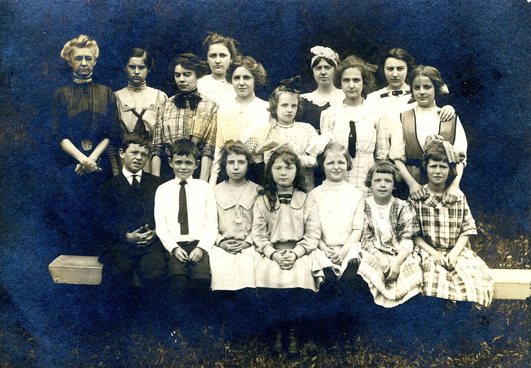 Frances Gatchel shown third from the right, bottom row, in this class picture from the Villa Ridge School. Her Great Aunt Fannie Craig is standing, far left, in the back row. Courtesy Ed Shadburn.
Frances Gatchel shown third from the right, bottom row, in this class picture from the Villa Ridge School. Her Great Aunt Fannie Craig is standing, far left, in the back row. Courtesy Ed Shadburn.
His daughter, Frances, received her primary schooling at the Villa Ridge School run by her great-aunt Fanny Craig at Edgewood and graduated high school from Louisville Collegiate School, founded by Virginia Perrin Speed -- a relative through her grandfather, Austin Lightfoot Peay. She went on to complete her college degree at Vassar and attended Sorbonne University in Paris.
"Wink" also served as a model in several Kate Matthews photos. When her cousin, Louise Lawton, married Oliver Bagby in 1914, author Annie Fellows Johnston, who by then was living in The Beeches, gave her a journal to record her adventures on the trip to Annapolis.
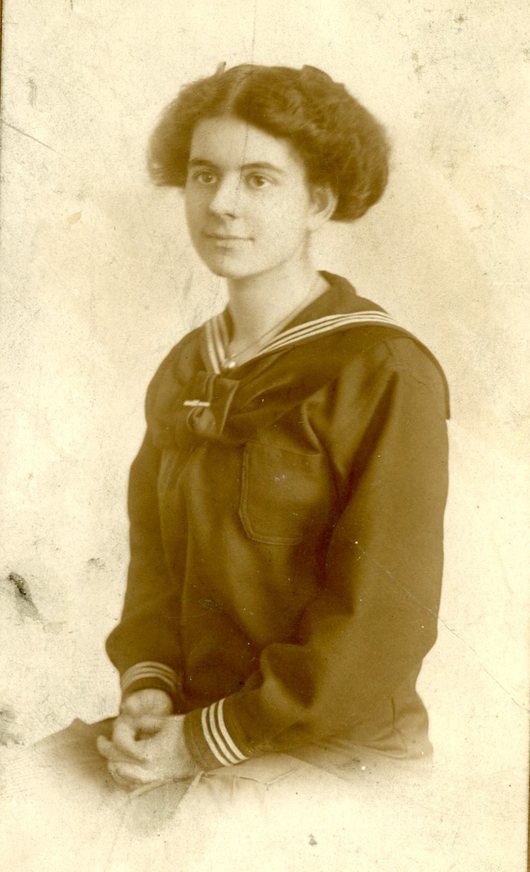 Catherine "Kitty" Lawton, from the Gatchel Family Collection, courtesy of Susan Lawson.
Catherine "Kitty" Lawton, from the Gatchel Family Collection, courtesy of Susan Lawson.
The inscription in the journal read:
Here is a little record book,
A sort of pilgrim satchel
To be filled with “Crabtown” memories
By its owner, Francis Gatchel
August, 1913
With all good wishes for a good journey from her neighbor across the way.
A.F. J.
Inside, Annie penned a story sprinkled with advice on how to use the journal:
To begin at the real beginning, this record ought to go back to the day that Frances first heard about the visit herself. For of course, one of the nicest things about going on a journey is that first blissful thrill that comes, that first moment when you find out that something so delightful as a visit is about to happen.
When she came over to The Beeches, her eyes shining to say “Guess What?” even the old squirrel on the bird pool stoped drinking and sat up straight to listen. Of course, his little Bunny brain couldn’t take in anything about “Annapolis” and “midshipman” and “engagements,” but he knew all about “Mamie” and the girls, and he whisked off like a flash of gray fur to find “Bobby” and tell her that “Wink” was going away to stay till the first dear “Lady of The Beeches” came back to visit her old home.
And to make the record complete, some mention ought to be made of the days and days of anticipation that have to be lived through before the Day of Starting actually rolls around. And the packing and re-packing of one’s little trinkets and belongs – they all count in the sum when one adds up happiness.
Here is a little record book,
A sort of pilgrim satchel
To be filled with “Crabtown” memories
By its owner, Francis Gatchel
August, 1913
With all good wishes for a good journey from her neighbor across the way.
A.F. J.
Inside, Annie penned a story sprinkled with advice on how to use the journal:
To begin at the real beginning, this record ought to go back to the day that Frances first heard about the visit herself. For of course, one of the nicest things about going on a journey is that first blissful thrill that comes, that first moment when you find out that something so delightful as a visit is about to happen.
When she came over to The Beeches, her eyes shining to say “Guess What?” even the old squirrel on the bird pool stoped drinking and sat up straight to listen. Of course, his little Bunny brain couldn’t take in anything about “Annapolis” and “midshipman” and “engagements,” but he knew all about “Mamie” and the girls, and he whisked off like a flash of gray fur to find “Bobby” and tell her that “Wink” was going away to stay till the first dear “Lady of The Beeches” came back to visit her old home.
And to make the record complete, some mention ought to be made of the days and days of anticipation that have to be lived through before the Day of Starting actually rolls around. And the packing and re-packing of one’s little trinkets and belongs – they all count in the sum when one adds up happiness.
Frances Gatchel Sampson (1904-1962) Photos, Courtesy of Ed Shadburn
During WWI, Frances and Billy were featured in a December 15, 1917 Courier-Journal article about a Christmas Cheer Club for the soldiers who were stationed at Camp Zachary Taylor in Louisville:
GIVE UP TOYS
FOR SOLDIERS
Gatchel Children Voluntarily
Sacrifice Christmas Joy
______________
Gifts for Camp Santa Claus
Come from Distance.
______________
LETTERS REVEAL SPIRIT
Among the many gratifying revelations of noble sentiments that have marked the Courier-Journal Camp Zachary Taylor Christmas Cheer Club campaign there stands out prominently the renunciation of Christmas toys this year by two children at Pewee Valley, Billy Gatchel, age 9, and Frances Gatchel, 11, son and daughter of F.E. Gatchel of W.D. Gatchel & Sons.
Both of these little people voluntarily gave up their customary Christmas this year that the money which would have been used in buying toys for them might be used for the purchase of gifts for the soldiers at Camp Zachary Taylor.
What Young Folk Sent
Their gifts for the soldiers have already been received and stored by the Courier-Journal Christmas Cheer Club. Little Miss Gatchel sent a box containing five packages of writing paper, four French and German books, three decks of playing cards, two pencils, eight khaki-colored handkerchiefs, two pocketknives and two metal sewing kits. Miss Gatchel may be sure that the blessings as well as the thanks of the soldiers will be hers in full measure.
W.D. Gatchel & Sons also contributed $5 to the soldiers Santa Claus Fund...
GIVE UP TOYS
FOR SOLDIERS
Gatchel Children Voluntarily
Sacrifice Christmas Joy
______________
Gifts for Camp Santa Claus
Come from Distance.
______________
LETTERS REVEAL SPIRIT
Among the many gratifying revelations of noble sentiments that have marked the Courier-Journal Camp Zachary Taylor Christmas Cheer Club campaign there stands out prominently the renunciation of Christmas toys this year by two children at Pewee Valley, Billy Gatchel, age 9, and Frances Gatchel, 11, son and daughter of F.E. Gatchel of W.D. Gatchel & Sons.
Both of these little people voluntarily gave up their customary Christmas this year that the money which would have been used in buying toys for them might be used for the purchase of gifts for the soldiers at Camp Zachary Taylor.
What Young Folk Sent
Their gifts for the soldiers have already been received and stored by the Courier-Journal Christmas Cheer Club. Little Miss Gatchel sent a box containing five packages of writing paper, four French and German books, three decks of playing cards, two pencils, eight khaki-colored handkerchiefs, two pocketknives and two metal sewing kits. Miss Gatchel may be sure that the blessings as well as the thanks of the soldiers will be hers in full measure.
W.D. Gatchel & Sons also contributed $5 to the soldiers Santa Claus Fund...
Death of Frank Gatchel
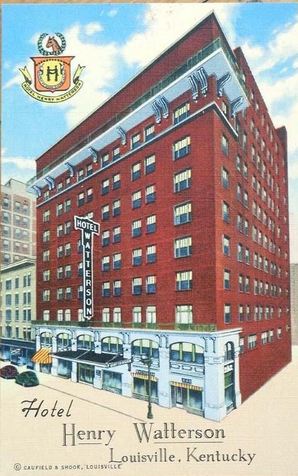 Watterson Hotel in the 1940s.
Watterson Hotel in the 1940s.
.
Business at the camera shop ebbed and flowed. Frank’s adopted grandson, the late John Cleaver Gatchel, said his father, Billy, used to tell the tale of the Thanksgiving when financial concerns forced them to serve duck instead of turkey. When Frank got older, Cleve said he kept a room downtown at the Watterson Hotel, between 4th and 5th streets, where he napped after lunch. One afternoon in 1942, he went to sleep and never woke up. He was brought to Jewish Hospital, where he died several days later on March 20.
His obituary ran in the March 21, 1942 Courier-Journal:
F.E. Gatchel Dies;
Headed Photo Firm
Frank E. Gatchel, 72, for nearly half a century in the photographic supplies business in Louisville, died at 2 p.m. yesterday at Jewish Hospital after a brief illness following a heart attack.
Proprietor of W.D. Gatchel and Sons, 5th and Walnut, Mr. Gatchel lived at Pewee Valley.
His experience in the photographic business went back to the old "wet plate" days and he had seen the development of the industry from those times to the present day high speed film, highly machines cameras, flash equipment and color materials.
Father Founded Firm
The firm he headed was founded by his father in Cincinnati in 1868, and eventually Mr. Gatchel and his brother, the late Bert Gatchel, were taken in as partners. Frank Gatchel came to Louisville in 1893 and established a branch of the business here and has operated it at various locations in the city since. His son, William C. Gatchel, has been associated with the firm for some years.
Mr. Gatchel was active in Boy Scout and church work. He was Sunday School Superintendent at the Pewee Valley Presbyterian Church. His major hobby was the study of ancient cultures and archeology -- a field in which he was considered an expert.
He is survived also by a daughter, Mrs. James Sampson, of Harlan, Ky.
Business at the camera shop ebbed and flowed. Frank’s adopted grandson, the late John Cleaver Gatchel, said his father, Billy, used to tell the tale of the Thanksgiving when financial concerns forced them to serve duck instead of turkey. When Frank got older, Cleve said he kept a room downtown at the Watterson Hotel, between 4th and 5th streets, where he napped after lunch. One afternoon in 1942, he went to sleep and never woke up. He was brought to Jewish Hospital, where he died several days later on March 20.
His obituary ran in the March 21, 1942 Courier-Journal:
F.E. Gatchel Dies;
Headed Photo Firm
Frank E. Gatchel, 72, for nearly half a century in the photographic supplies business in Louisville, died at 2 p.m. yesterday at Jewish Hospital after a brief illness following a heart attack.
Proprietor of W.D. Gatchel and Sons, 5th and Walnut, Mr. Gatchel lived at Pewee Valley.
His experience in the photographic business went back to the old "wet plate" days and he had seen the development of the industry from those times to the present day high speed film, highly machines cameras, flash equipment and color materials.
Father Founded Firm
The firm he headed was founded by his father in Cincinnati in 1868, and eventually Mr. Gatchel and his brother, the late Bert Gatchel, were taken in as partners. Frank Gatchel came to Louisville in 1893 and established a branch of the business here and has operated it at various locations in the city since. His son, William C. Gatchel, has been associated with the firm for some years.
Mr. Gatchel was active in Boy Scout and church work. He was Sunday School Superintendent at the Pewee Valley Presbyterian Church. His major hobby was the study of ancient cultures and archeology -- a field in which he was considered an expert.
He is survived also by a daughter, Mrs. James Sampson, of Harlan, Ky.
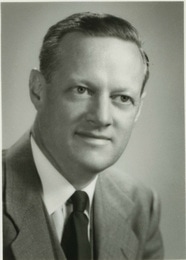 William Culbertson "Billy" Gatchel. Courtesy of his son, Cleave.
William Culbertson "Billy" Gatchel. Courtesy of his son, Cleave.
His will is on file at the Oldham County Courthouse. Thanks to Oldham County Clerk Julie Barr for providing the Pewee Valley Historical Society with a copy:
May 18, 1938
Being in good health and sound mind, I make this, my last will and testament.
I wish to leave my two children Frances Gatchel Sampson and William C. Gatchel, whatever possessions I may have in my possession at the time of my death and appoint them (Frances Sampson and Wm. C. Gatchel) and my son in law, James R. Samson, executors of my estate without bond.
I wish to make a few bequests after all bills against me have been paid, as follows,
To the Pewee Valley Presbyterian Church, I would like to leave from $100.00 to $500.00 as generously as the condition of my estate will permit.
To Mamie Johnson Sadler I would like to leave $100.00 and to Narcisse Pope $100.00 in remembrance of their faithful services.
I plan to lay aside the sum of $2000.00 to go to the education of my grandson, Frank E. Gatchel. If able I shall segregate that sum and so designate its purpose. If I do not succeed in doing that, then I wish it to be taken from the estate.
The balance of the estate to be left in equal portions to my children.
F.E. Gatchel
Frank’s son Billy succeeded his father as president of W.D. Gatchel & Sons and served until his death in 1953, when the small plane he was piloting crashed between Evansville and Louisville. He was replaced as head of the company by his natural son, Frances Edwin Gatchel, II, and later, by his adopted son, Cleve. The company eventually closed its doors in 1990.
May 18, 1938
Being in good health and sound mind, I make this, my last will and testament.
I wish to leave my two children Frances Gatchel Sampson and William C. Gatchel, whatever possessions I may have in my possession at the time of my death and appoint them (Frances Sampson and Wm. C. Gatchel) and my son in law, James R. Samson, executors of my estate without bond.
I wish to make a few bequests after all bills against me have been paid, as follows,
To the Pewee Valley Presbyterian Church, I would like to leave from $100.00 to $500.00 as generously as the condition of my estate will permit.
To Mamie Johnson Sadler I would like to leave $100.00 and to Narcisse Pope $100.00 in remembrance of their faithful services.
I plan to lay aside the sum of $2000.00 to go to the education of my grandson, Frank E. Gatchel. If able I shall segregate that sum and so designate its purpose. If I do not succeed in doing that, then I wish it to be taken from the estate.
The balance of the estate to be left in equal portions to my children.
F.E. Gatchel
Frank’s son Billy succeeded his father as president of W.D. Gatchel & Sons and served until his death in 1953, when the small plane he was piloting crashed between Evansville and Louisville. He was replaced as head of the company by his natural son, Frances Edwin Gatchel, II, and later, by his adopted son, Cleve. The company eventually closed its doors in 1990.
Gatchel's Ads: 1940s-1960s
The Gatchel Family Plot at Cave Hill Cemetery
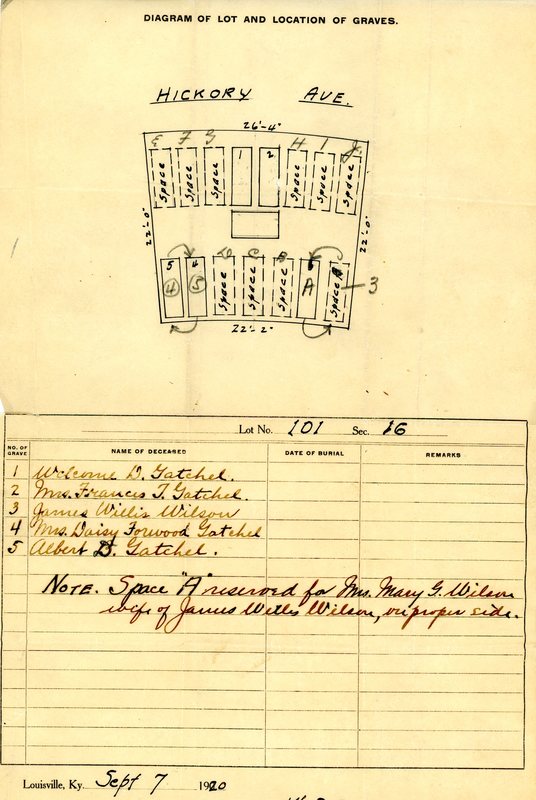
On September 20, 1920, Frank Gatchel purchased Section 16, Lot 101 at Cave Hill Cemetery to create a family burial space at the cemetery. He had the bodies of his parents; brother Albert; Albert's wife Daisy; and brother-in-law James Willis Wilson, moved to the new plot. He also reserved a space beside J.W. Wilson for his sister, Mary.
The cost for creating the family plot, based on his handwritten notes, came in at a grand total of $828.70, broken down as follows:
Cost of Changes of Lots with Cave Hill
Price of Lot 101, Section 16 $589.20
Cleaning & Removing Monument-New
Foundation 118.60
Preparing? Graves and Foundation of
Stones 115.00
___________
822.80
Rebates Old Lot -199.10
____________
623.70
Three New Markers 205.00
____________
$828.70
Frank and Alice, however, aren't buried with the Gatchel family. They rest side-by-side with the Craigs in Section O, Lot 216, with Alice's grandparents and several aunts and uncles.
Recent History
After Frank’s death, Woodside went through several different owners and was briefly owned by Theodore Klein, founder of Yew Dell Gardens in Crestwood, Ky. Klein purportedly took cuttings from some of the more unusual plants on the property for his landscaping business. In the 1940s, it was purchased from Col. Earl Major by the Utley family.
1940s Photos of Woodside, Courtesy of the Late B. Utley Murphy
Today, Woodside is owned by St. Aloysius Catholic Church, which purchased the property and its 4.6 acres on June 28, 2002 from Sam and Darlene Durham for $585,000. The church used a portion of the acreage to expand their parking and add an entrance off Central Avenue. In the spring of 2007, they cleared nearly all the trees from the property to make way for a sports field. The plan also called for Woodside’s demolition. Pewee Valley residents pleaded the case for historic conservation to both the congregation and the archdiocese, and an agreement was reached to keep Woodside intact for 20 years. What will become of it after that, who knows?
1989 Photos of Woodside by Carolyn Brooks for the Central Avenue Historic District Nomination to the National Register of Historic Places
Related Links

